Brush
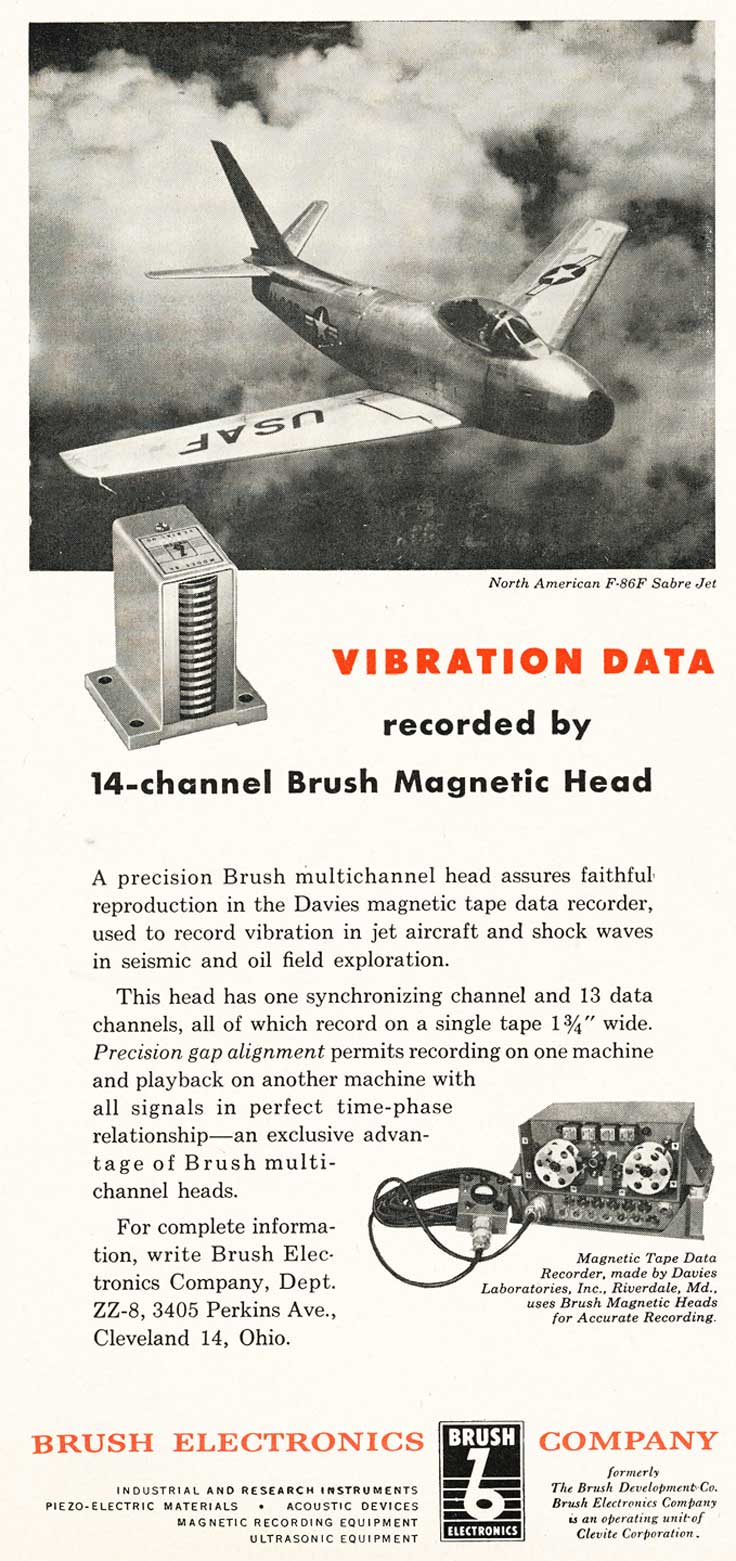 Originally founded in 1919 by Charles Francis Brush Jr. as Brush Labs, a research company based in Cleveland, Ohio, the company was started with the intention to develop phonographic products that utilized piezoelectric crystals. Mr. Brush died prematurely in 1927 but his backers founded the Brush Development Company in 1930 to commercialize the inventions of Brush Labs. The newly formed company became the USA's biggest manufacturer of instrument recorders and other test and measurement instrumentation in the latter half of the 30s. Brush's main business in 1943 was the production of piezoelectric phonograph pickups.
Originally founded in 1919 by Charles Francis Brush Jr. as Brush Labs, a research company based in Cleveland, Ohio, the company was started with the intention to develop phonographic products that utilized piezoelectric crystals. Mr. Brush died prematurely in 1927 but his backers founded the Brush Development Company in 1930 to commercialize the inventions of Brush Labs. The newly formed company became the USA's biggest manufacturer of instrument recorders and other test and measurement instrumentation in the latter half of the 30s. Brush's main business in 1943 was the production of piezoelectric phonograph pickups.
Another of their products was wire recorders. These used ferromagnetic stainless steel wire, with a composition similar to high carbon high chromium cutlery steel as the recording medium. The recording head was a split ring, with the wire running in a groove in the head, quite similar to the heads used today. High frequency AC bias was used to linearize the recording. The ferritic stainless steel was quite strong. Diamond dies were required to draw it into wire.
The newly formed company became the USA's biggest manufacturer of instrument recorders and other test/measurement instrumentation in the latter half of the 30's. Due to their status in that market segment, Brush was chosen by the US Army to work on recording technologies during World War II, while the company continued to work on magnetic recording technologies.
The Brush Vice President for Research, Dr. Semi Joseph Begun, obtained a contract from the US National Defense Research Council to perform research and development on a substitute for the stainless steel wire. The work was justified by the military use of the recorders and the shortage of facilities for producing the diamond dies. It resulted in the production through work at Battelle Memorial Institute of iron oxide magnetic recording tape of exceptional quality.
After the war they were not made privy to the improved technologies behind Telefunken's WWII era Magnetophon by the US Army. Like others working in that field, it has been hinted that this was possibly because the company had been exclusively handed the research and manufacturing secrets of high quality crystals that had been developed in Germany during the war, and had even been given access to the German scientists that had developed the techniques; it was felt that Brush had got "their share".
In 1946Brush released the Mail-A-Voice dictation recorder. The Mail-A-Voice was the first magnetic disc recorder. In his book Magnetic Recording, Semi Joseph Begum says "It was used by department stores. Parent bought the equipment and gave a unit to their son or daughter who might be away from home and kept one unit at their own disposal. The powder-coated discs were mailed and served as "spoken" letters. Today's floppy discs for computers are basically an outgrowth of the original discs for correspondence.
Brush released the first USA built tape recorder in 1947 with the Brush Soundmirror. Brush's first ad appeared in the October 11, 1947 issue of the Saturday Evening Post (rt). But those were designed with an eye on the outdated 1928 and 1935 German patents. This meant that the Soundmirror was soon outdated when machines built around the Magnetophon technology arrived on the market. For a time in the early 50's the company became the primary supplier of automated tape recorders for businesses such as aviation control and telephone exchanges. The company never gained the market share in the recording business.
Companies such as Sonotone managed during the late 40's to successfully market piezoelectric phonographic pickups, a market that Brush had set it's sights on ever since its founding, but never had any success.
To add insult to injury, one of the most successful companies in that sector was Astatic which was founded by an ex-Brush employee. Brush Development Co. merged with the original Brush Labs and the Cleveland Graphite Bronze company in 1952 with the resulting new company named Clevite. Audio products continued being sold using the Brush trademark as late as 1960. The Clevite company exited the audio market in 1963 and was taken over by Gould National Battery in 1969.
Go to Article by the Audio Engineering Society • Go to Brush Development Company Stories
Brush reel to reel tape recorders in the Reel2ReelTexas.com vintage recording collection
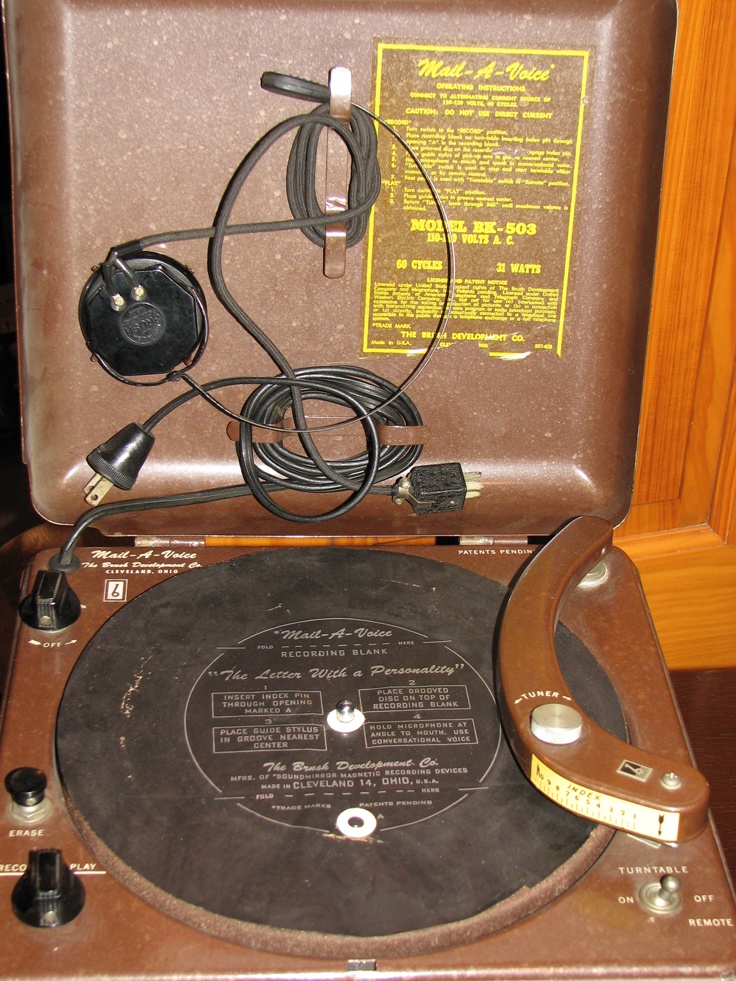
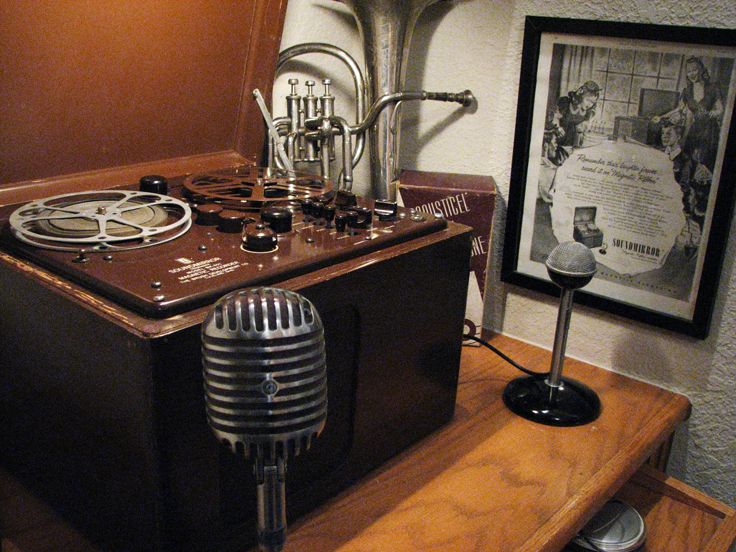
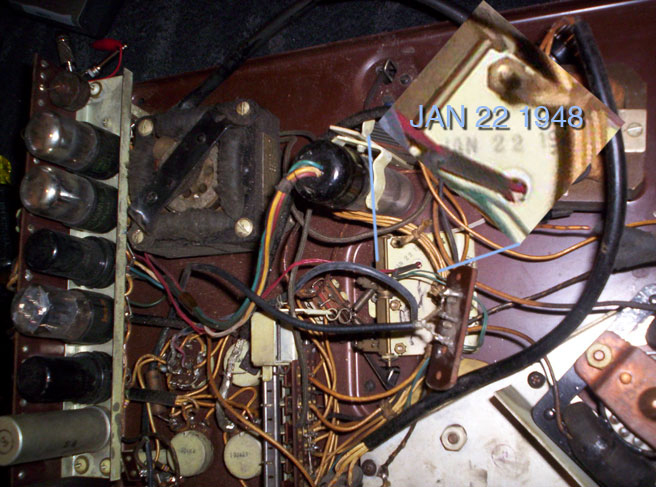

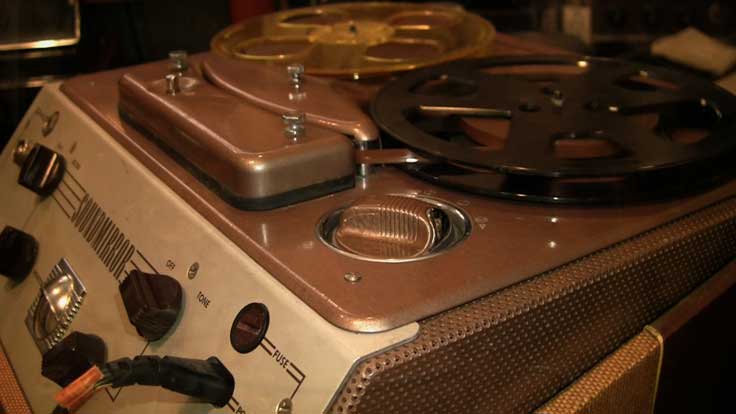
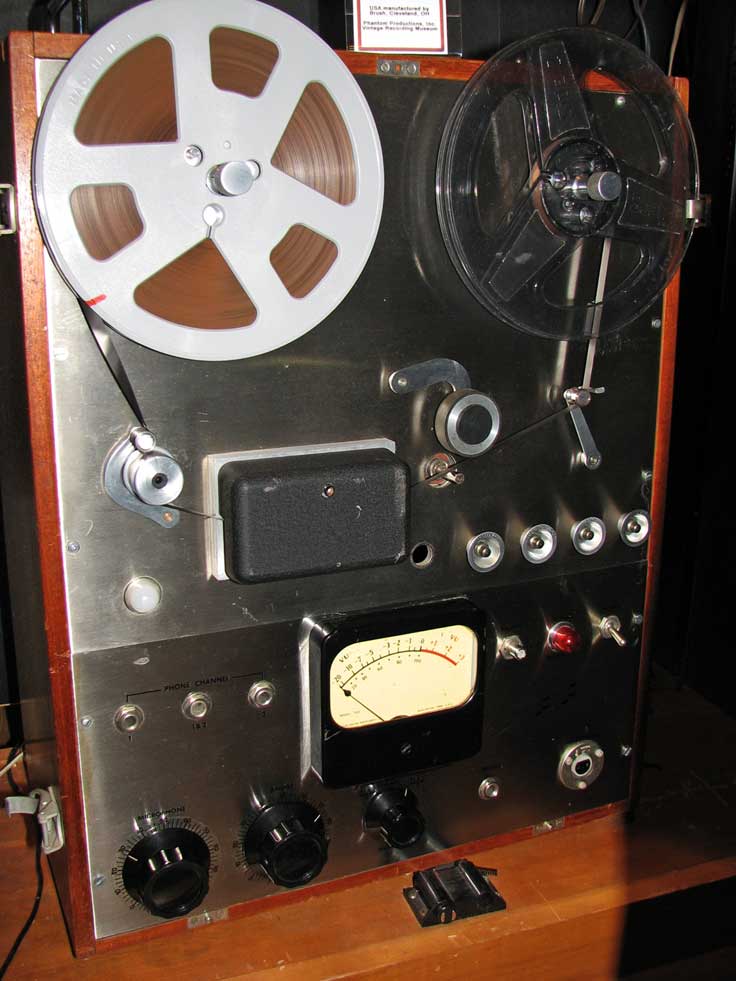
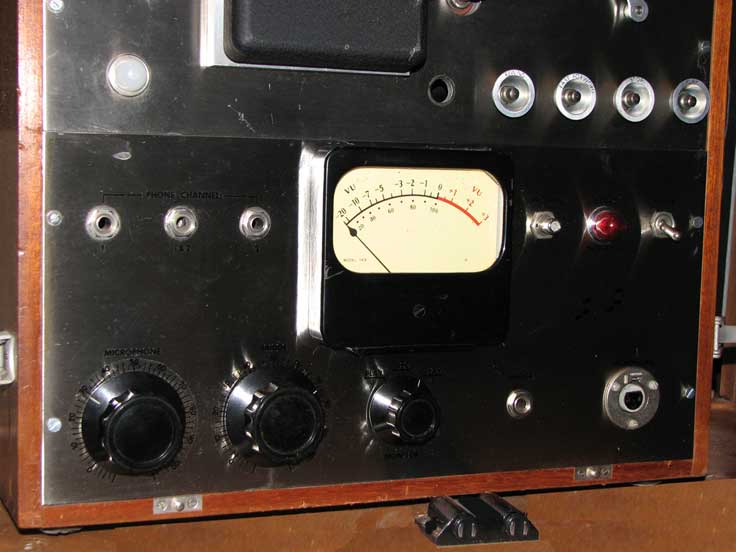
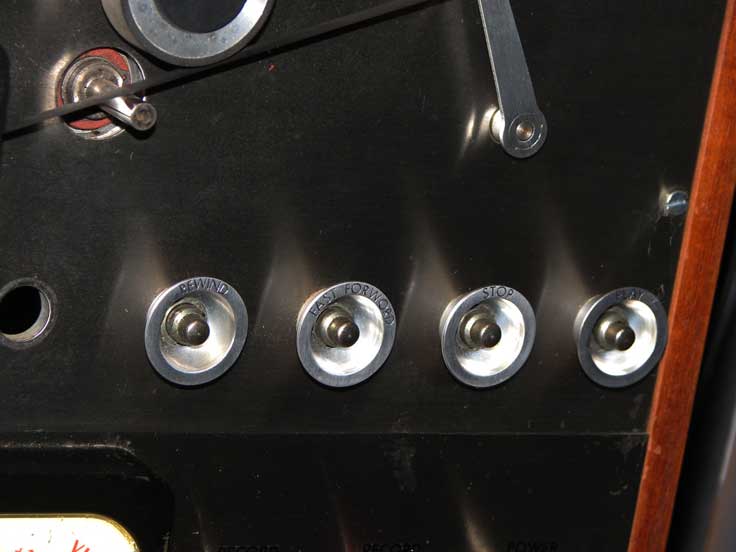
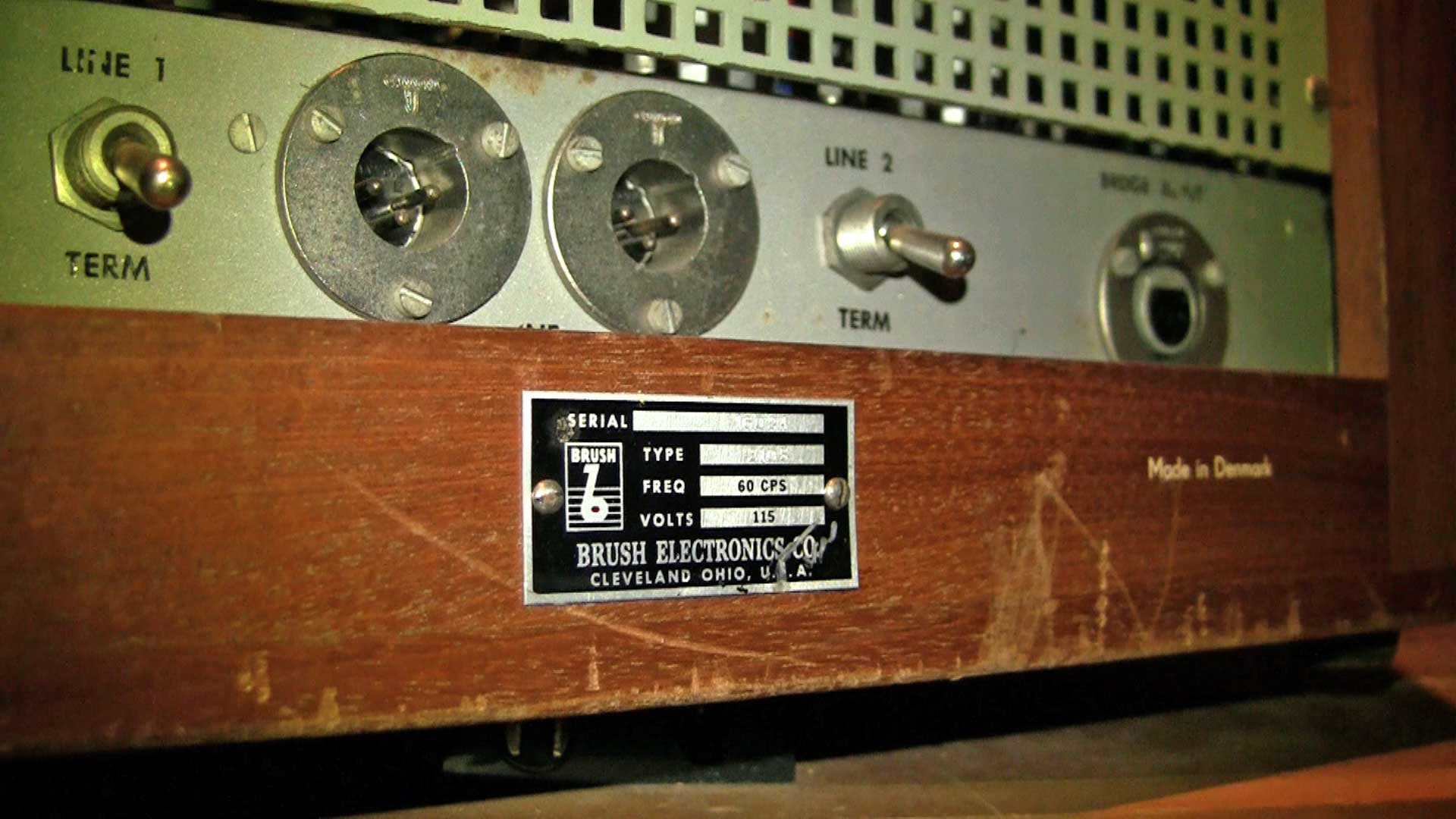
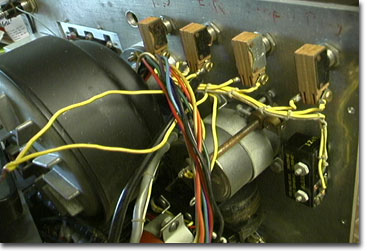
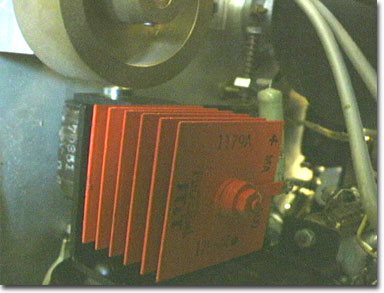
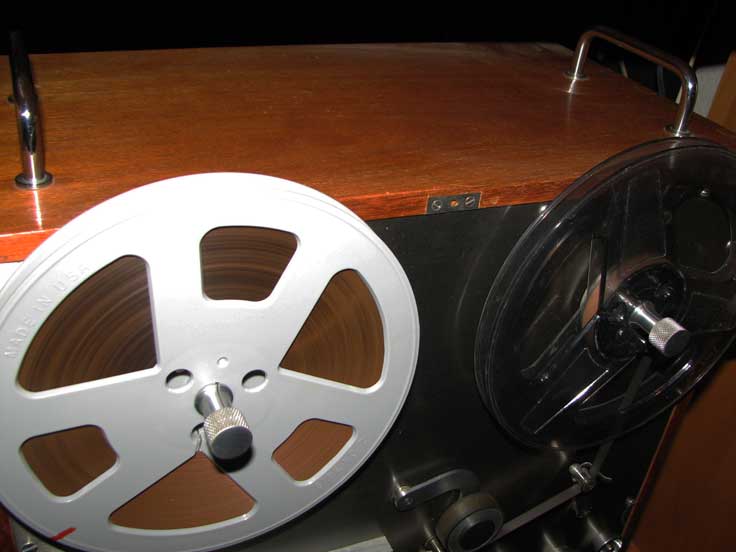
This is a very unique Brush BL-301 Vibration Transducer donated to our Museum by Dave Meyers of Overkill Audio, Inc. view pdf
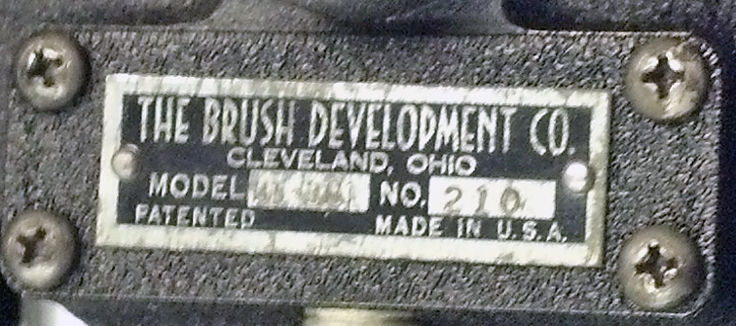
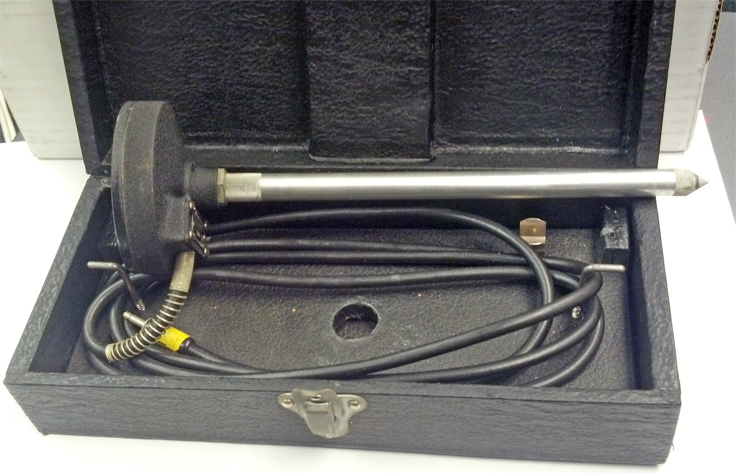
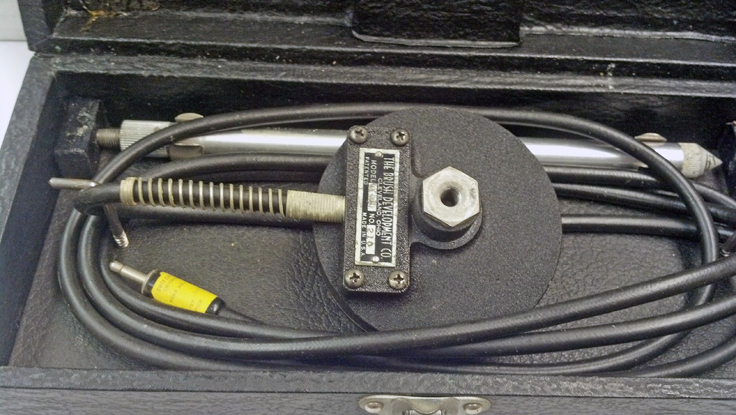

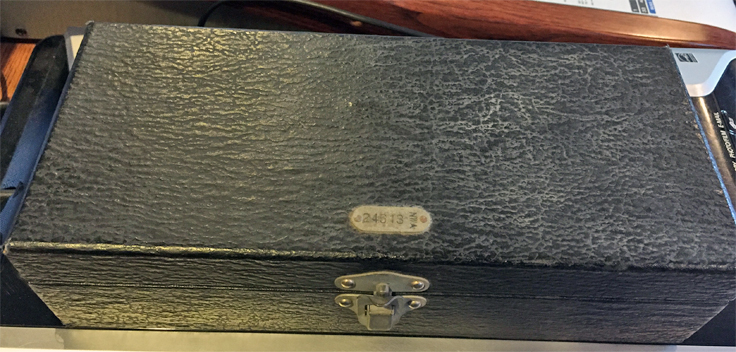
Brush Mail-A-Voice 1946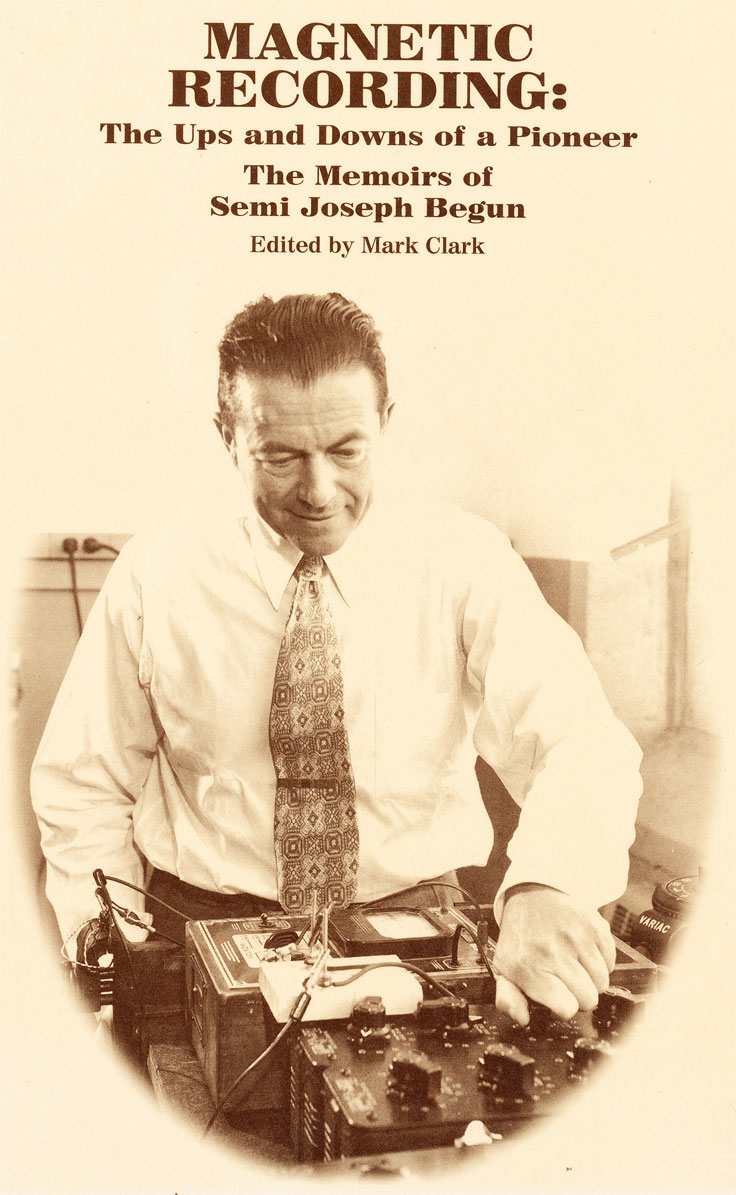
 The model BK-503 Mail-A-Voice from "The Brush Development Company", represents an entirely different approach to the problem of storing information on a magnetic medium. The recording material in this case is in the form of a 9-inch disc, and the sound track is a spiral running from an inner diameter of 5 inches to the outer edge. The recording track has a width of 0.014 inch, and the pitch of the spiral is 0.025 inch. Despite this close spacing, no noticeable crosstalk can be detected. The powder-coated paper discs can be folded and mailed like an ordinary letter. No guide grooves are provided on the coated discs.
The model BK-503 Mail-A-Voice from "The Brush Development Company", represents an entirely different approach to the problem of storing information on a magnetic medium. The recording material in this case is in the form of a 9-inch disc, and the sound track is a spiral running from an inner diameter of 5 inches to the outer edge. The recording track has a width of 0.014 inch, and the pitch of the spiral is 0.025 inch. Despite this close spacing, no noticeable crosstalk can be detected. The powder-coated paper discs can be folded and mailed like an ordinary letter. No guide grooves are provided on the coated discs.
After the war Brush released the Mail-A-Voice dictation recorder. The Mail-A-Voice was the first magnetic disc recorder. In his book Magnetic Recording, Semi Joseph Begum says "It was used by department stores. Parents bought the equipment and gave a unit to their son or daughter who might be away from home and kept one unit at their own disposal. The powder-coated discs were mailed and served as "spoken" letters. Today's floppy discs for computers are basically an outgrowth of the original discs for correspondence."
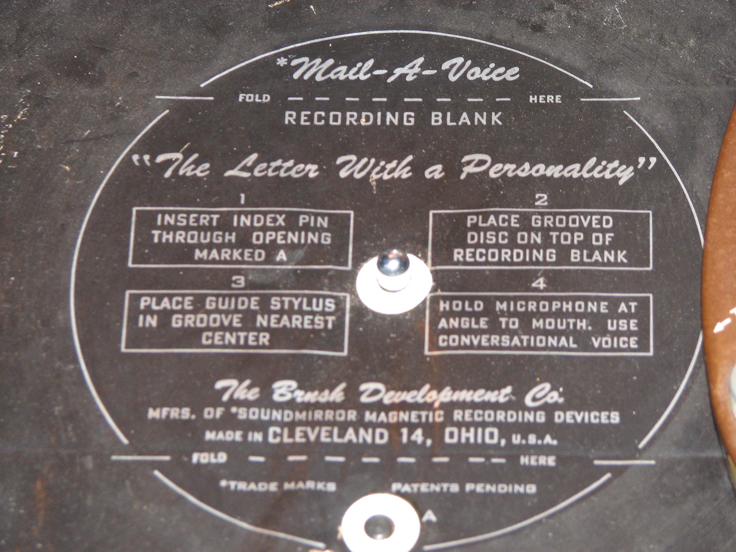
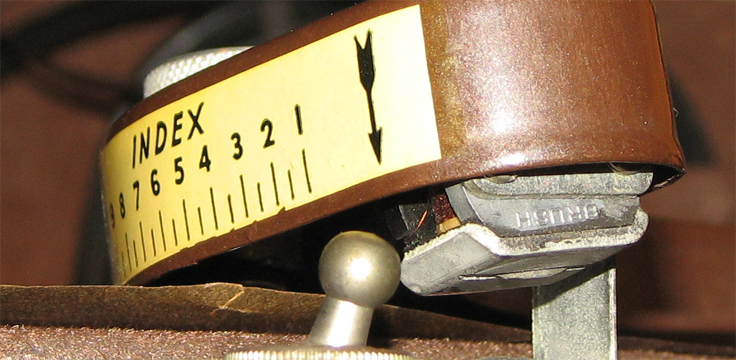
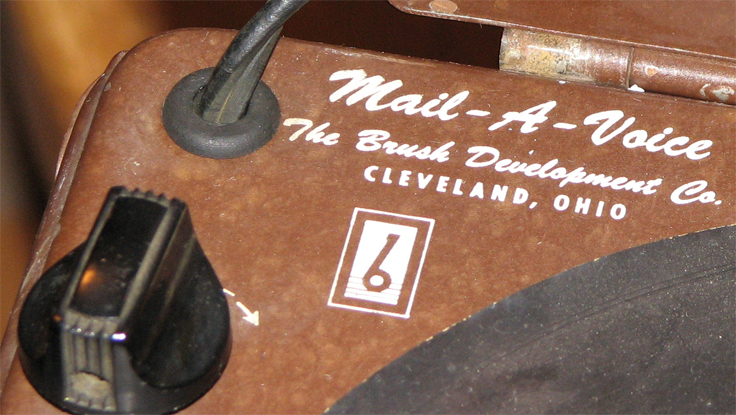
Brush Mail-A-Voice 1946
 The model BK-503 Mail-A-Voice from "The Brush Development Company", represents an entirely different approach to the problem of storing information on a magnetic medium. The recording material in this case is in the form of a 9-inch disc, and the sound track is a spiral running from an inner diameter of 5 inches to the outer edge. The recording track has a width of 0.014 inch, and the pitch of the spiral is 0.025 inch. Despite this close spacing, no noticeable crosstalk can be detected. The powder-coated paper discs can be folded and mailed like an ordinary letter. No guide grooves are provided on the coated discs.
The model BK-503 Mail-A-Voice from "The Brush Development Company", represents an entirely different approach to the problem of storing information on a magnetic medium. The recording material in this case is in the form of a 9-inch disc, and the sound track is a spiral running from an inner diameter of 5 inches to the outer edge. The recording track has a width of 0.014 inch, and the pitch of the spiral is 0.025 inch. Despite this close spacing, no noticeable crosstalk can be detected. The powder-coated paper discs can be folded and mailed like an ordinary letter. No guide grooves are provided on the coated discs.
After the war Brush released the Mail-A-Voice dictation recorder. The Mail-A-Voice was the first magnetic disc recorder. In his book Magnetic Recording, Semi Joseph Begum says "It was used by department stores. Parents bought the equipment and gave a unit to their son or daughter who might be away from home and kept one unit at their own disposal. The powder-coated discs were mailed and served as "spoken" letters. Today's floppy discs for computers are basically an outgrowth of the original discs for correspondence."



Here's a pdf regarding a TIMEX model
Recordon Magnetic Electronic Dictating Machine - United Kingdom
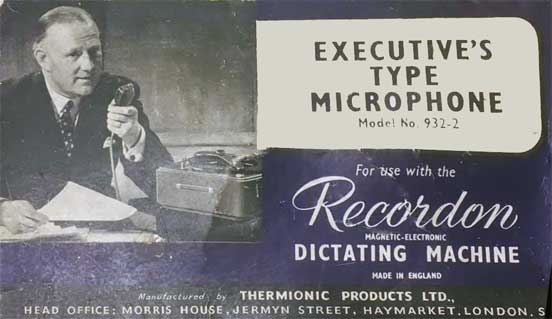 The stories of the Brush Development Company, Thermionic Products, Racal-Thermionics and Racal-Recorders are told in "A Truvox Product" - as will soon become clear!
The stories of the Brush Development Company, Thermionic Products, Racal-Thermionics and Racal-Recorders are told in "A Truvox Product" - as will soon become clear!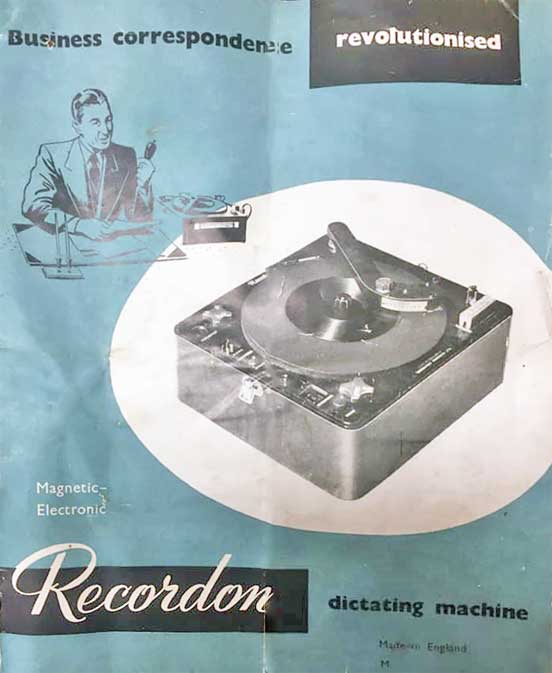
Founded in 1944 by Alfred Colley and Edward Angold, both had experience of piezo-electric devices and work on secret war-time communications equipment. Their work drew them to that being carried out by the American leaders in crystal and piezo-electric technology, the Brush Development Company. Following an exploratory visit to Brush in 1946, Angold became enamoured with America's new electronic flash-guns while Colley saw a commercial opportunity in Brush's magnetic recorders, developed by Semi Joseph Begun.
Thermionic Products' first product was Britain's first electronic flash-gun, the 'Mega-Flash', but while they also developed patents on cinematographic sound recording, their future lay in magnetic recording. Having secured rights to an improved Brush "Mail-a-Voice" disc recorder of 1946, they launched their "Recordon TP503" in spring 1948 using a B&Y fan motor, built by their subsidiary company. This was marketed as an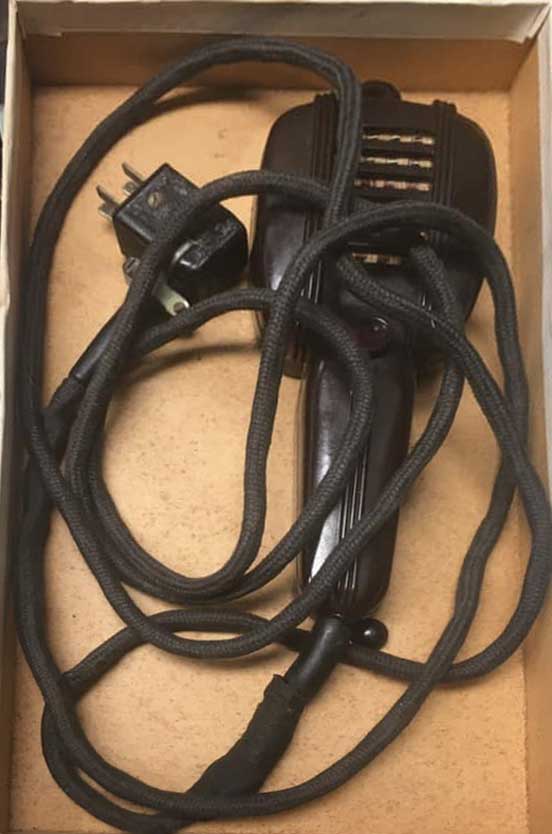
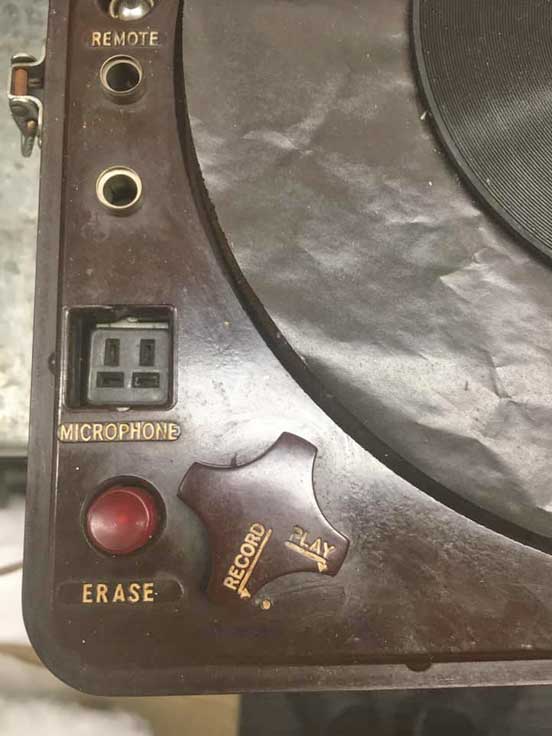 office dictating machine and operated very much like a gramophone, recording onto a 9" magnetic oxide coated paper disc which could be folded into three and posted to another office, making it especially popular with travelling salesmen.
office dictating machine and operated very much like a gramophone, recording onto a 9" magnetic oxide coated paper disc which could be folded into three and posted to another office, making it especially popular with travelling salesmen.
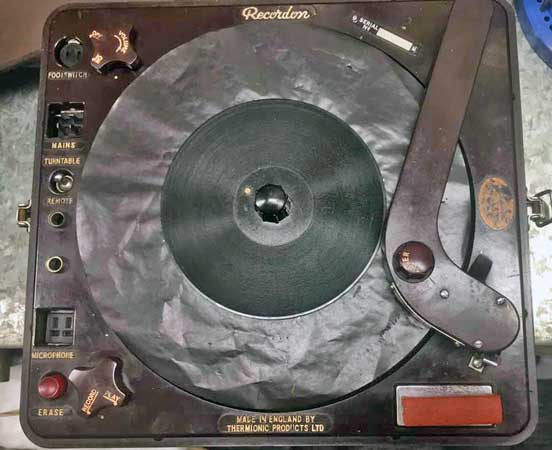 The Recordon's success allowed the company to take up offices in Jermyn Street, London. It was later produced at their new Hythe works, as an improved TP504, along with a deluxe 'Diplomat' version in 1953 which incorporated an intercom with the secretary and telephone amplifier. The Recordon survived into the mid-1950s when they took up assembly of the Swedish 'Agavox' recorder.
The Recordon's success allowed the company to take up offices in Jermyn Street, London. It was later produced at their new Hythe works, as an improved TP504, along with a deluxe 'Diplomat' version in 1953 which incorporated an intercom with the secretary and telephone amplifier. The Recordon survived into the mid-1950s when they took up assembly of the Swedish 'Agavox' recorder.
https://brenelltape.co.uk.websitebuilder.prositehosting.co.uk/thermionic-products
Brush Development Company / Brush Electronics Company ads
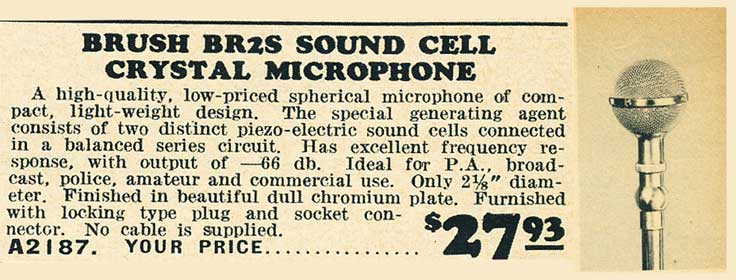
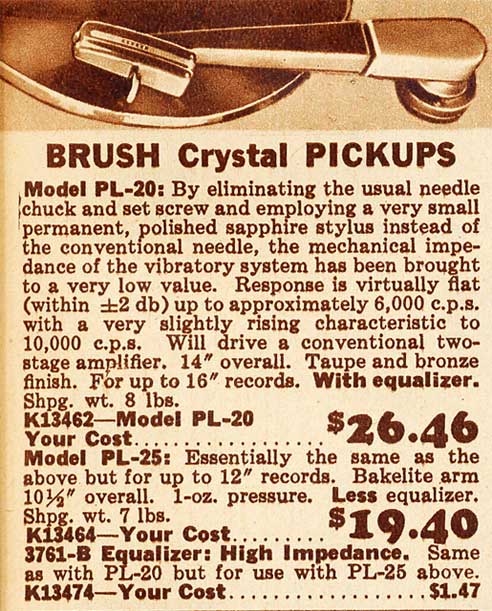
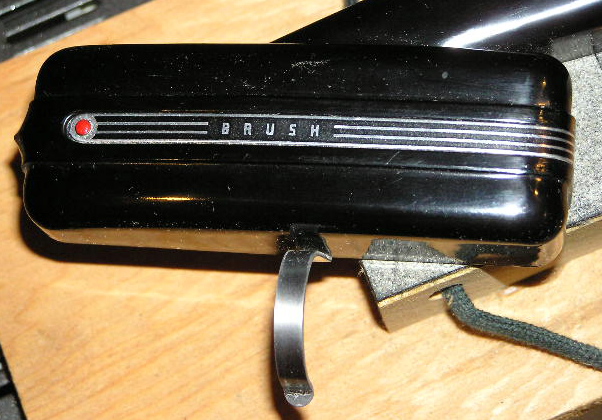
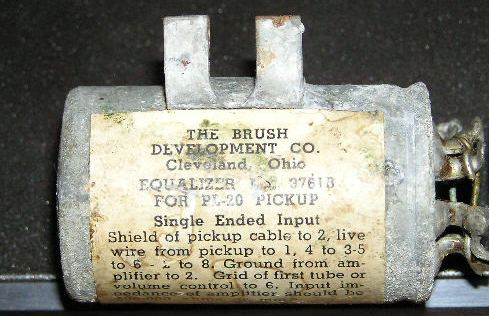
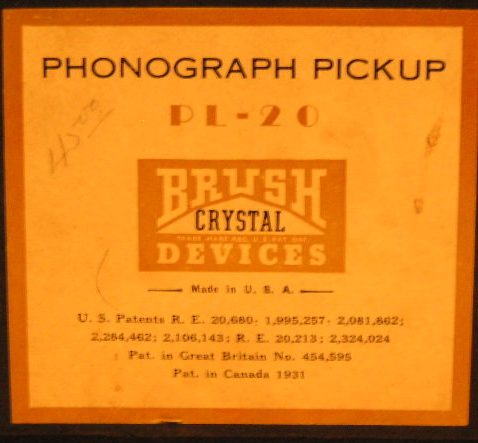
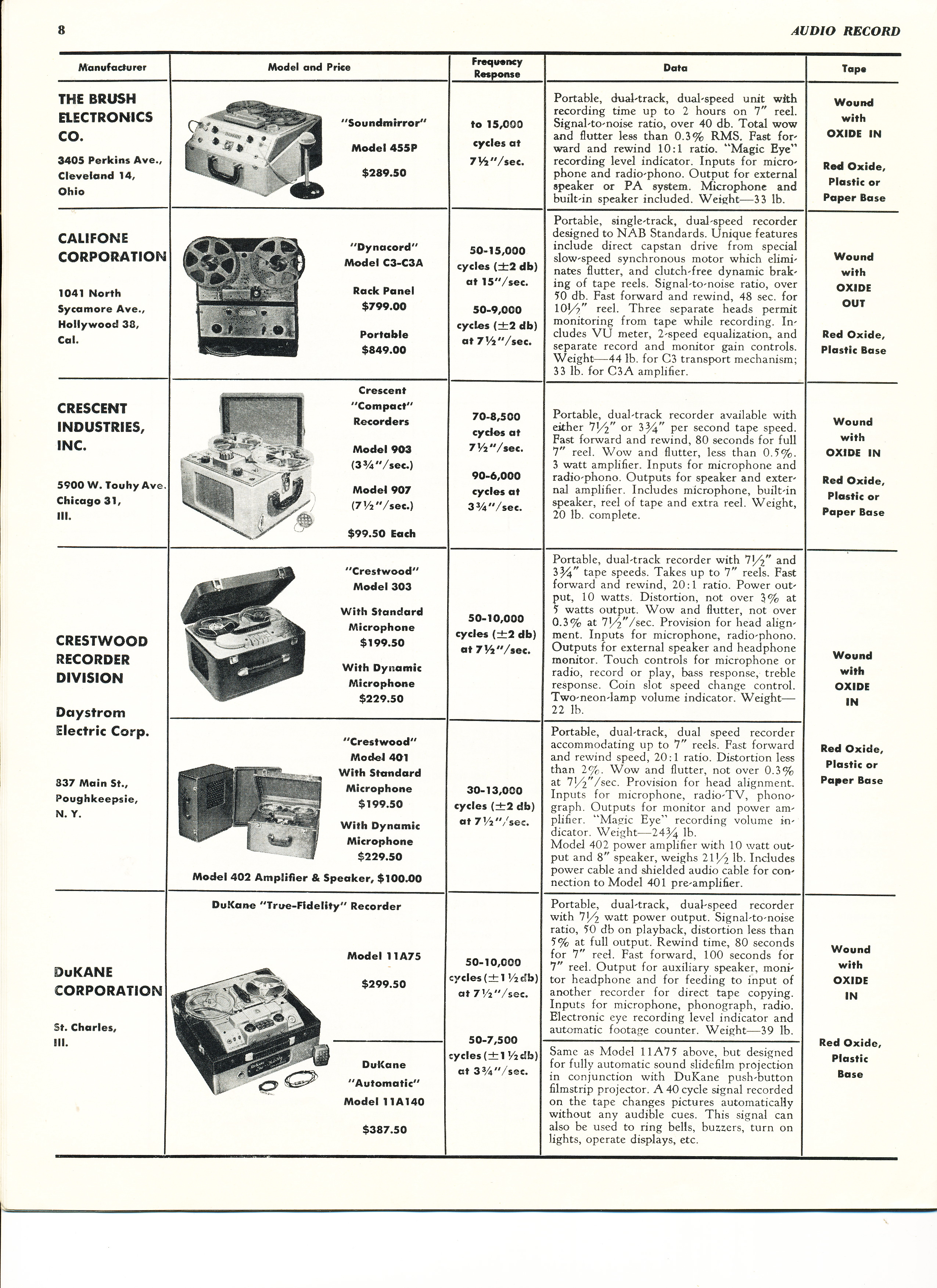
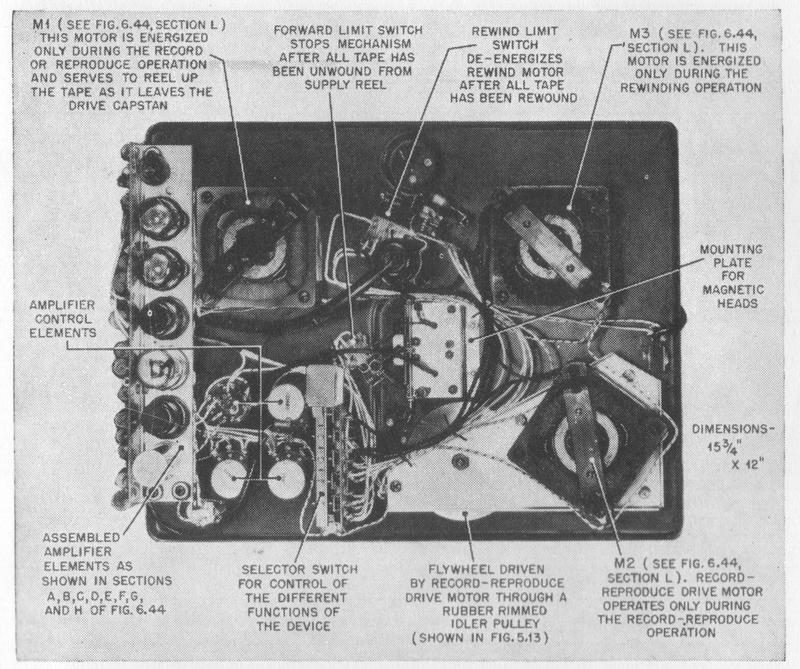
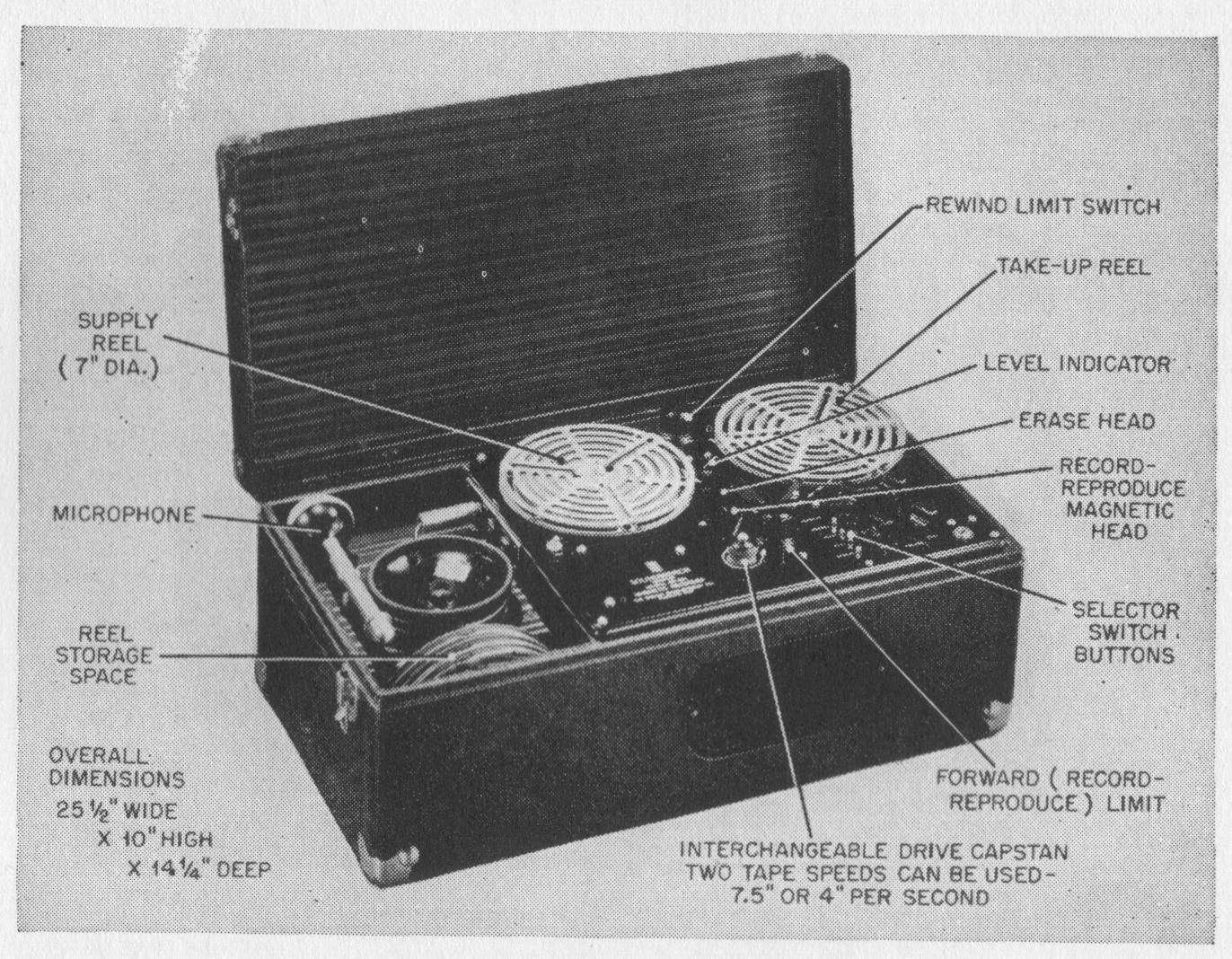
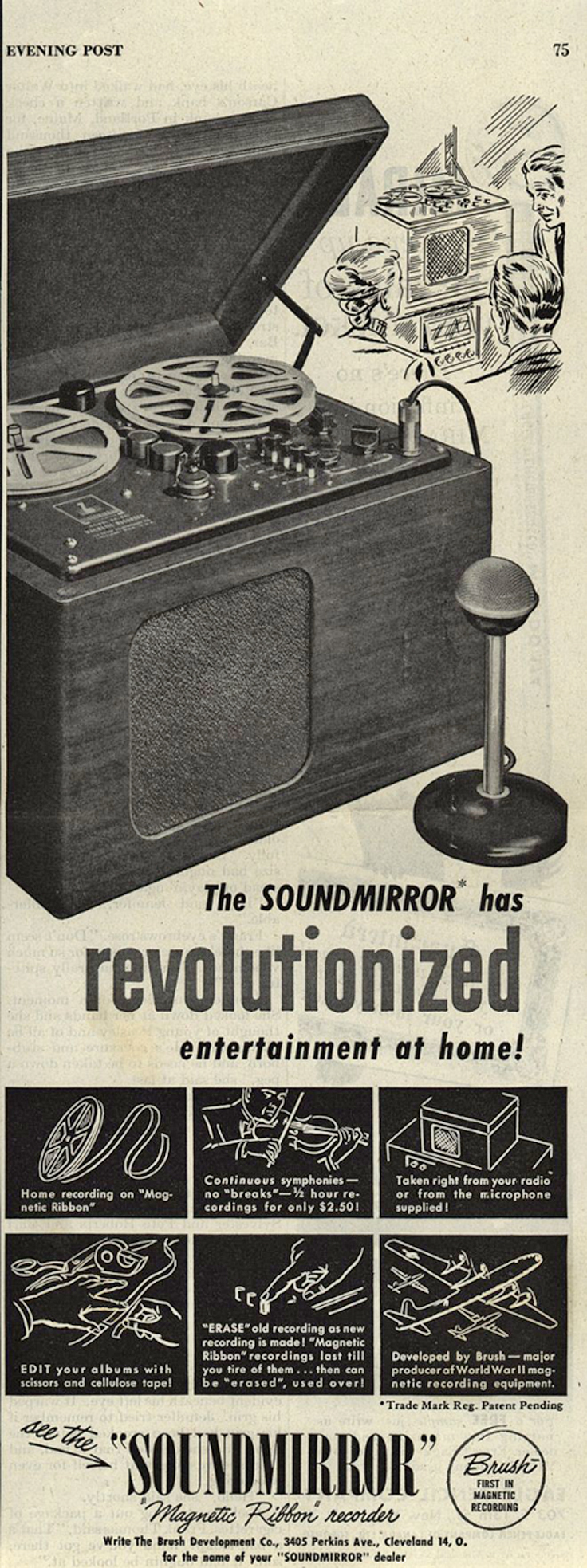

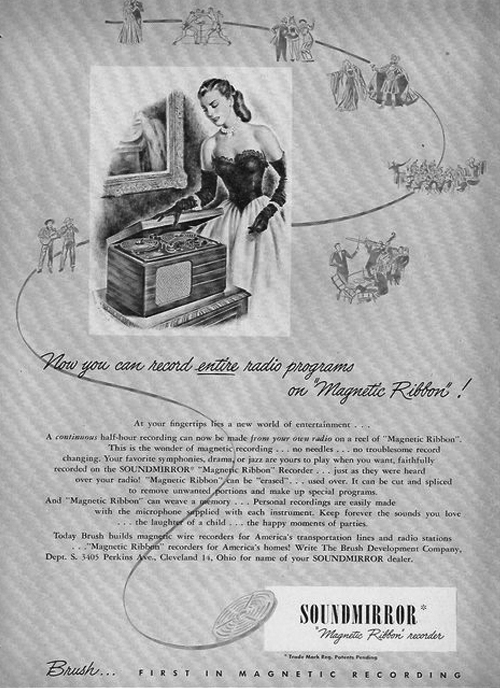
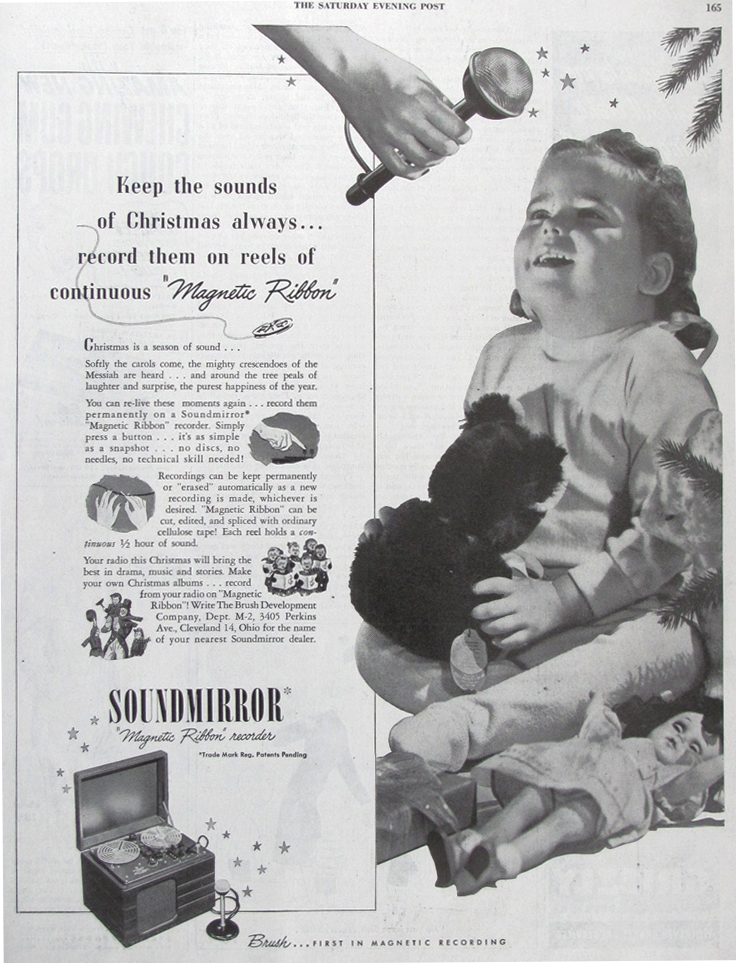

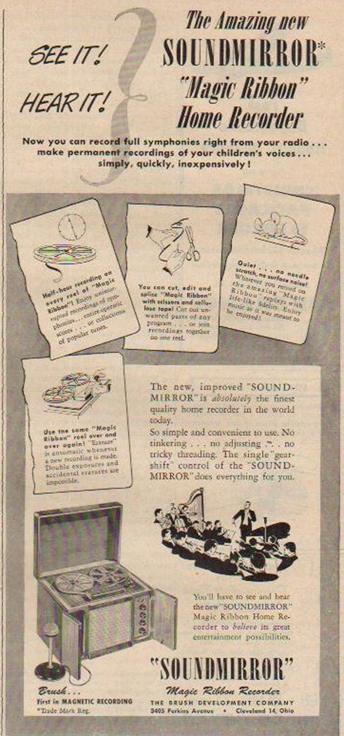
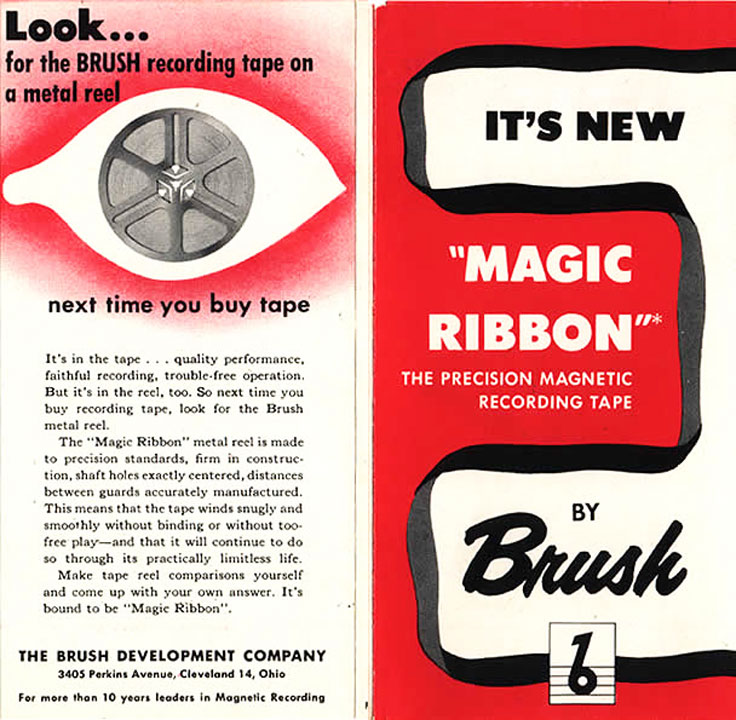

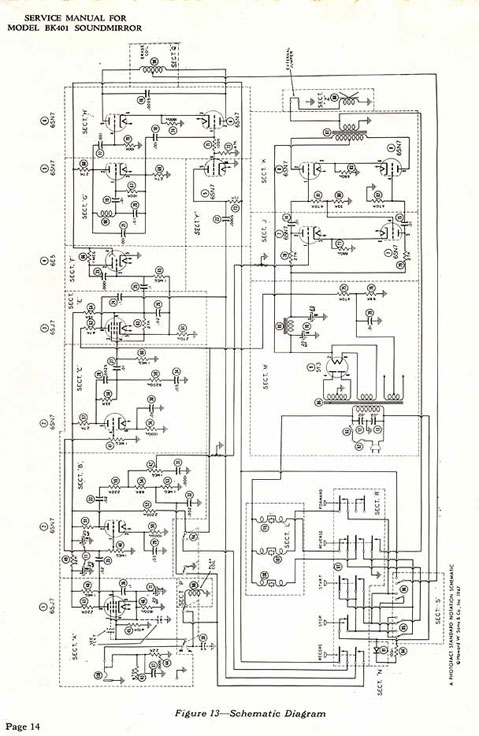
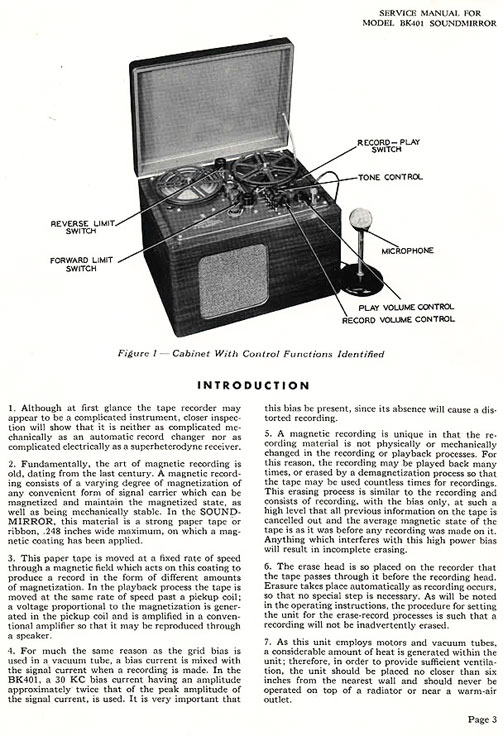
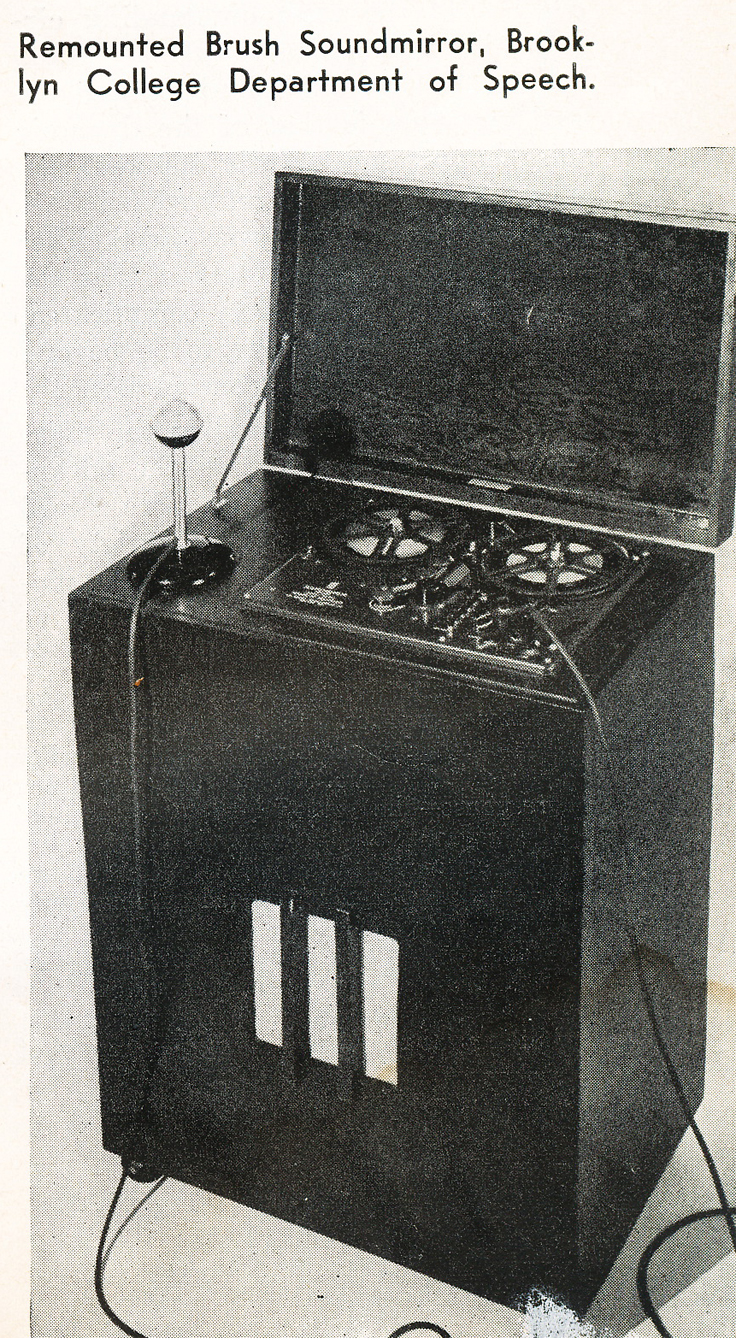
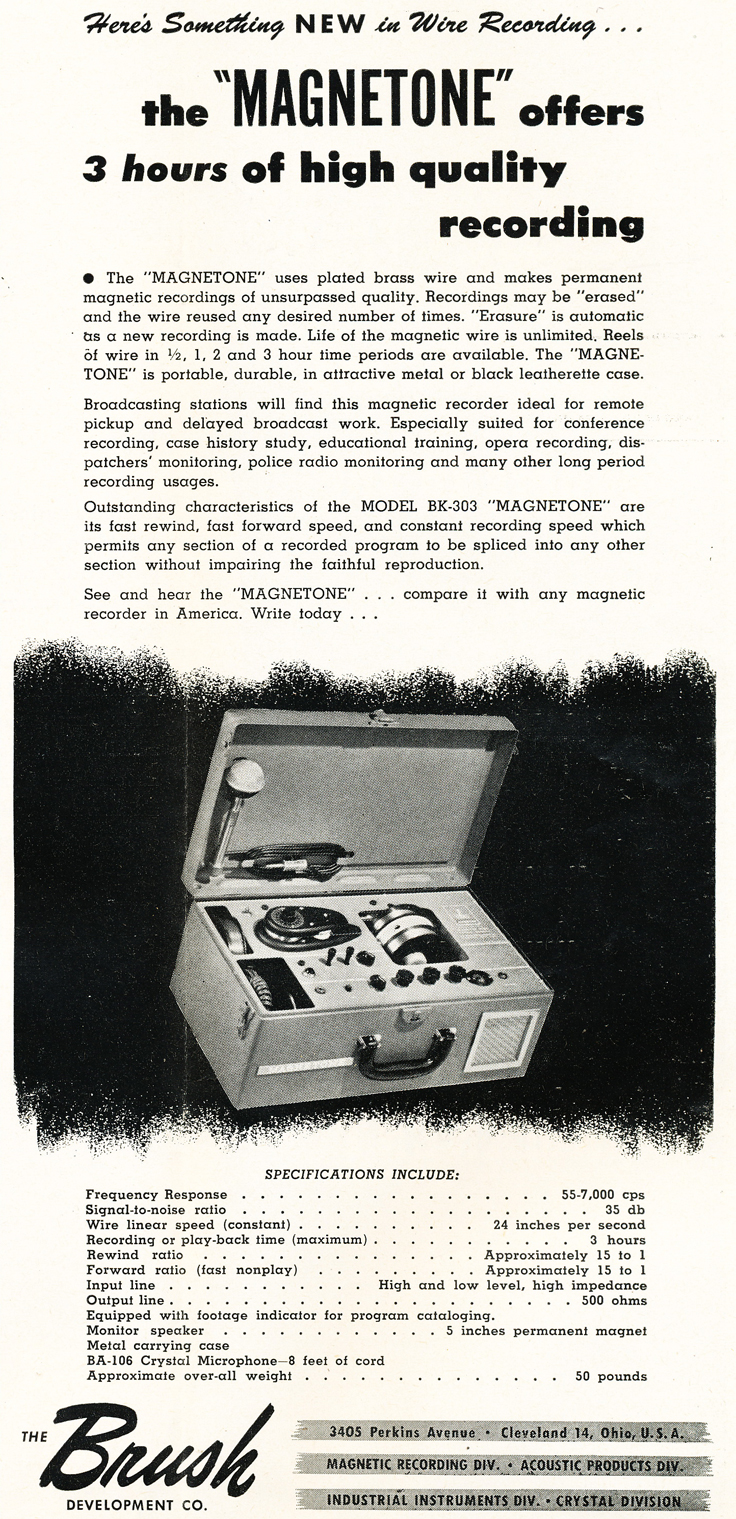
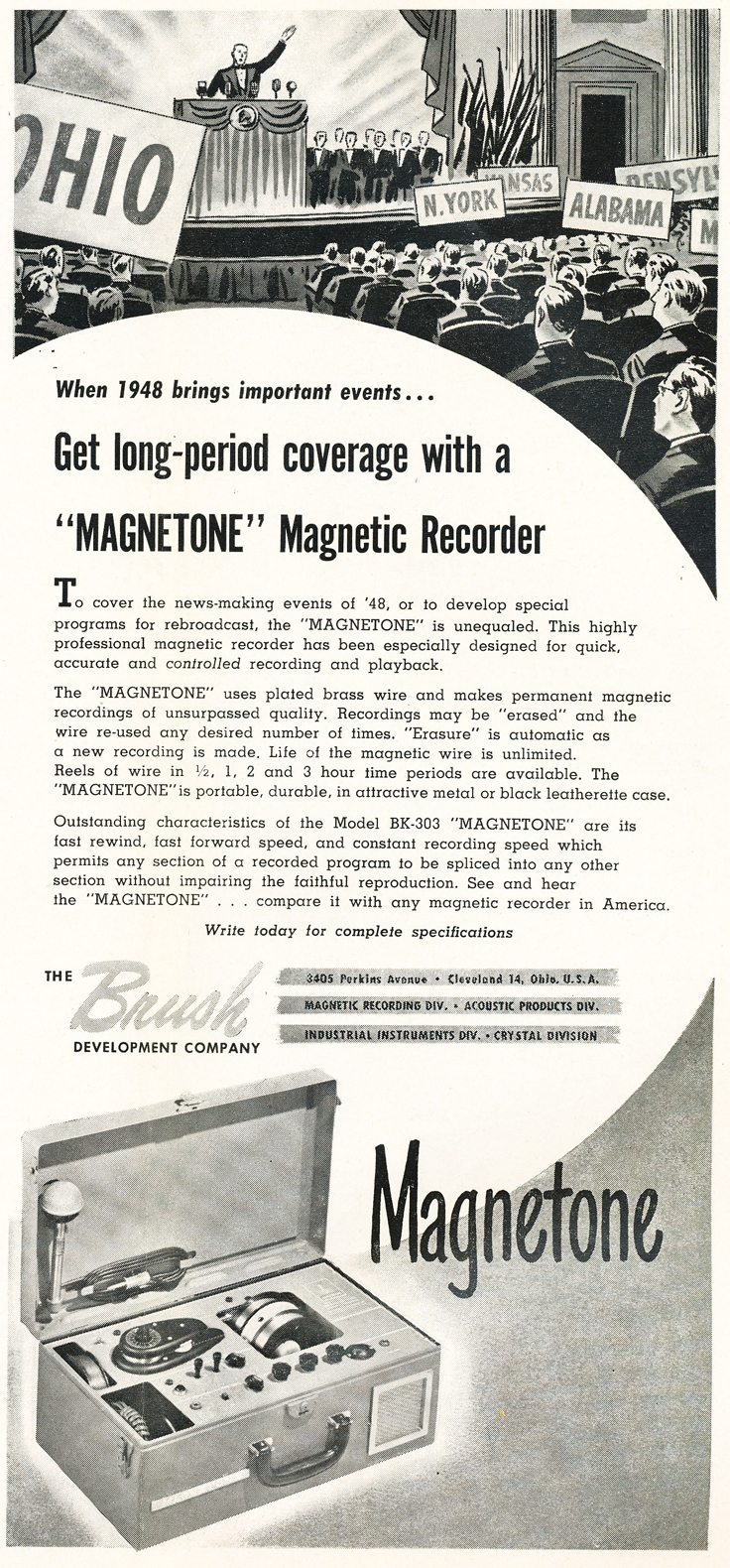
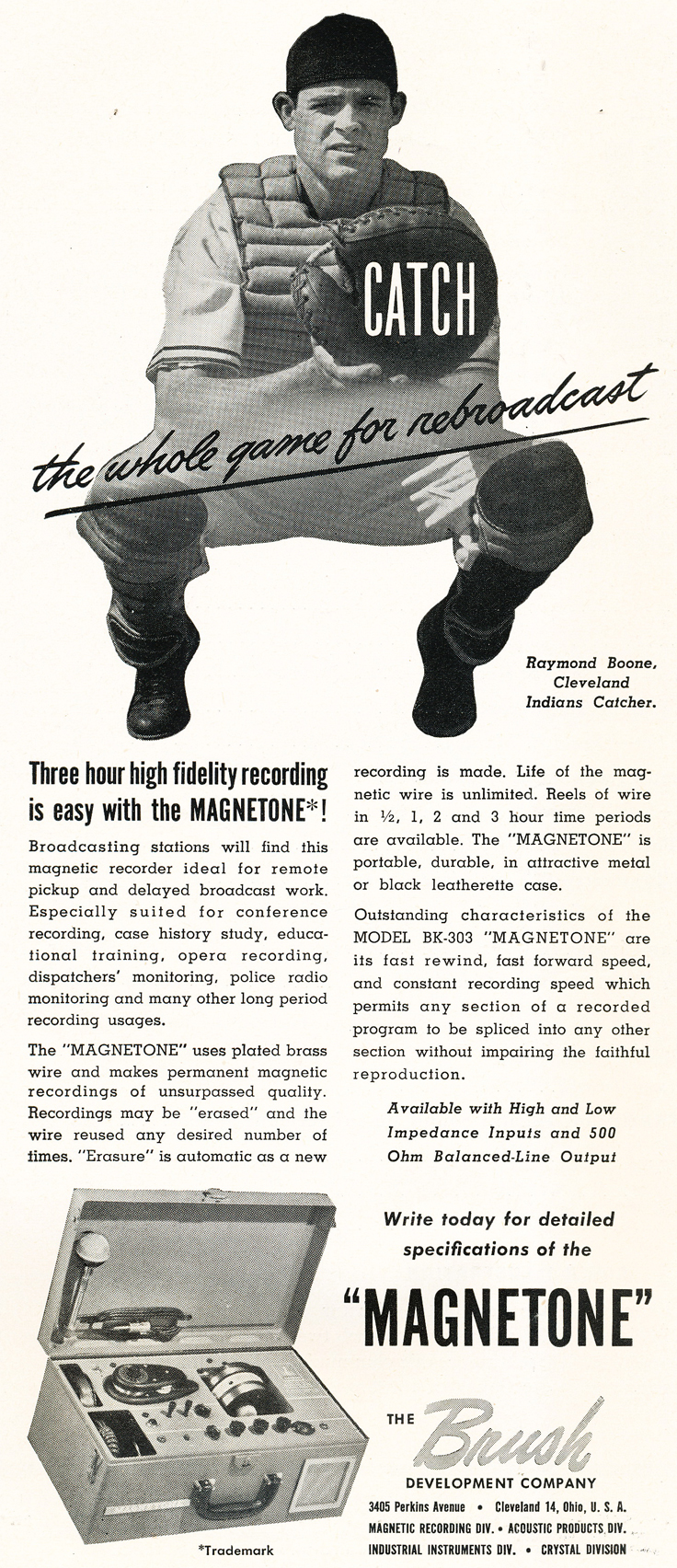
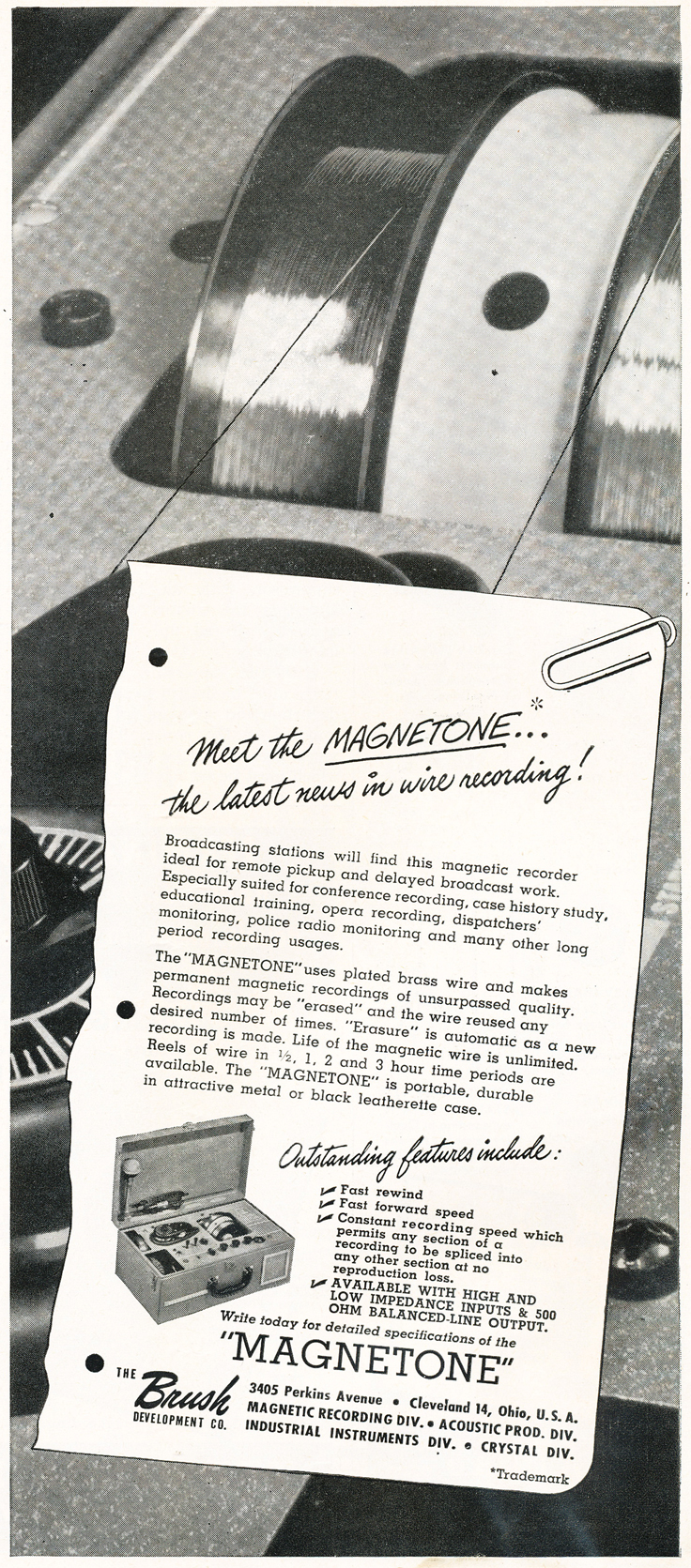

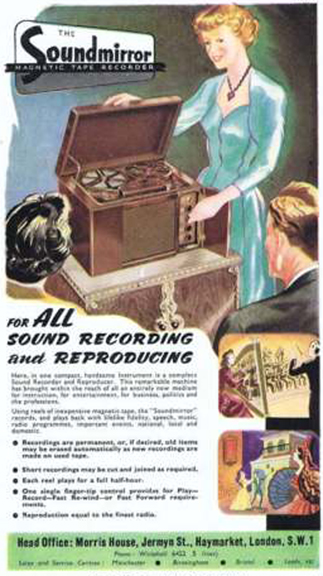
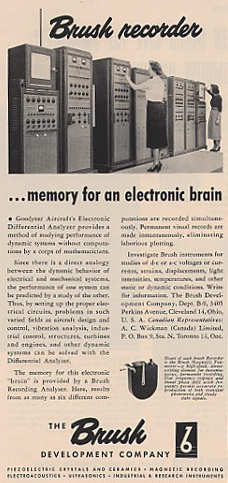
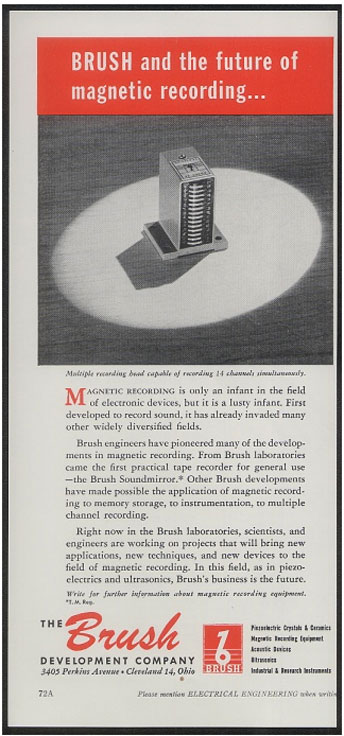
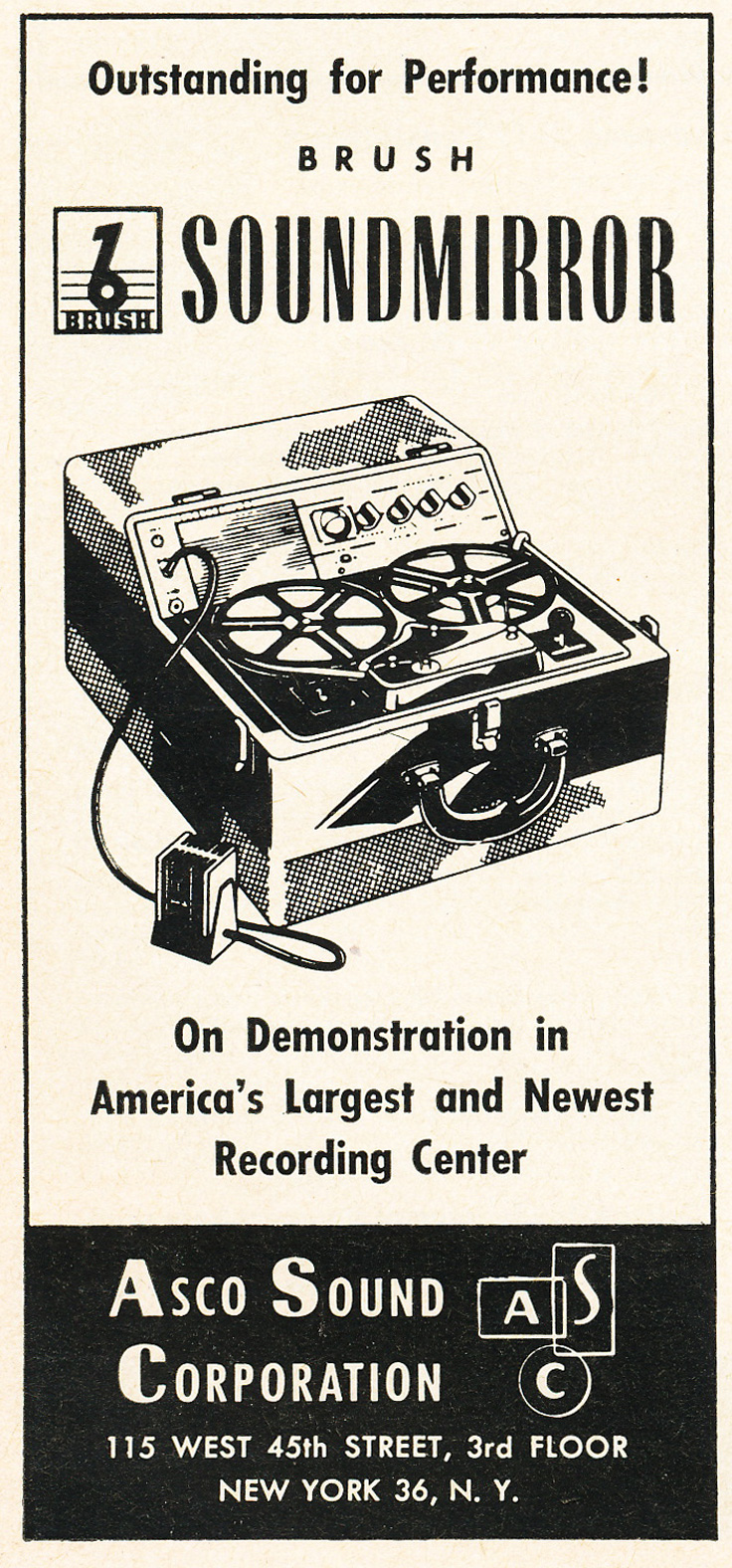
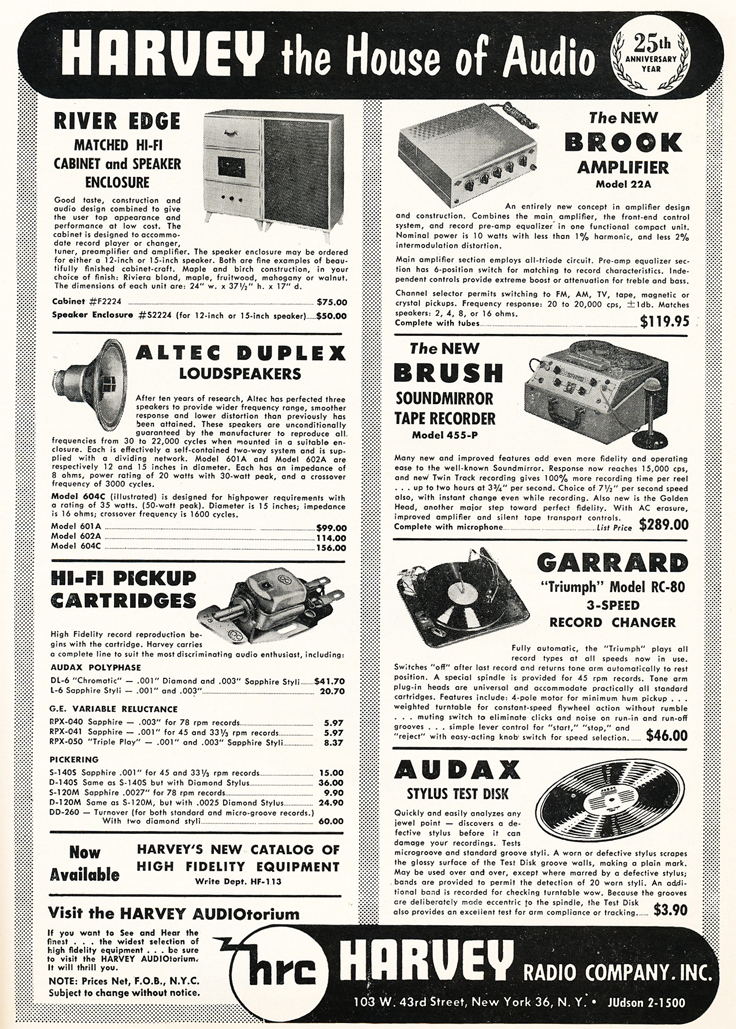
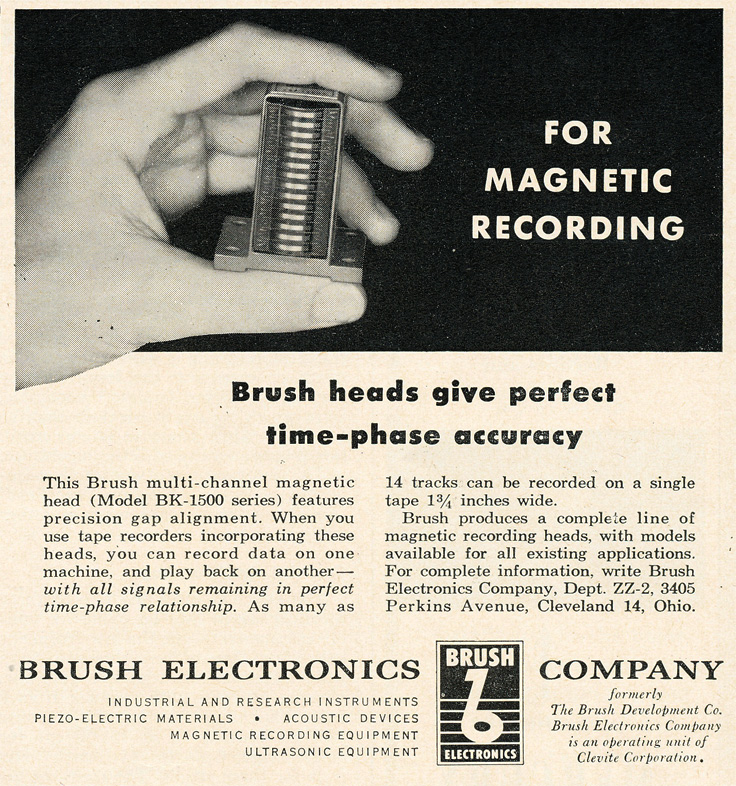
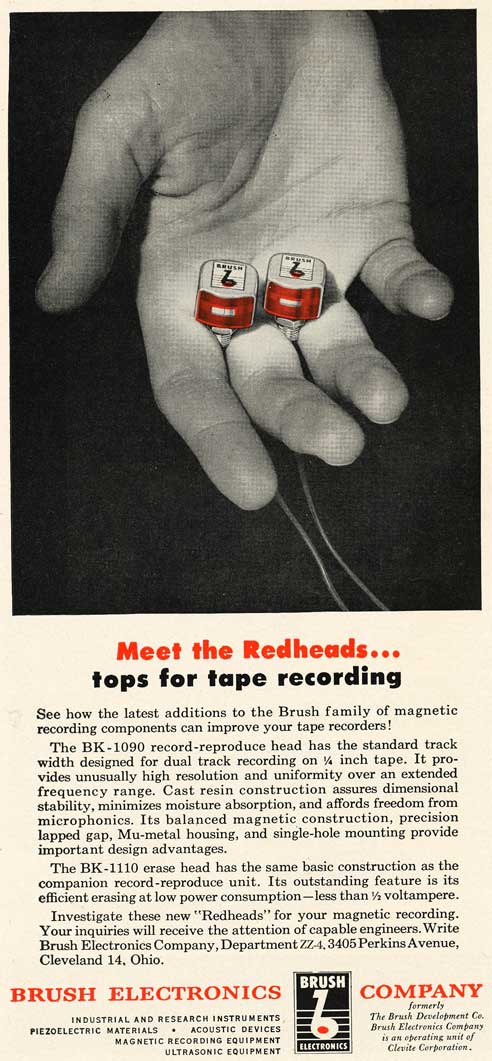


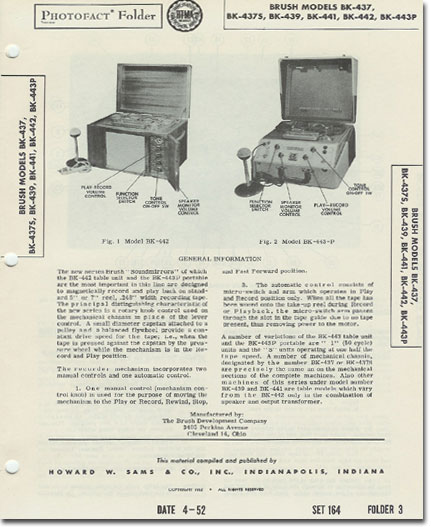
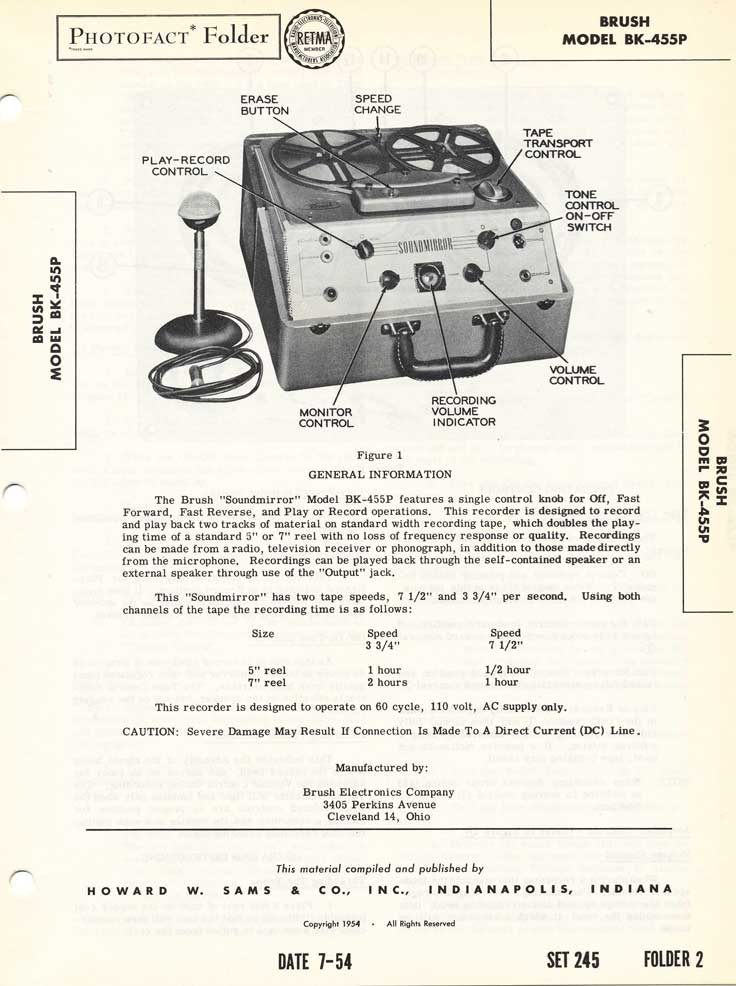
Brush photos contributed by others
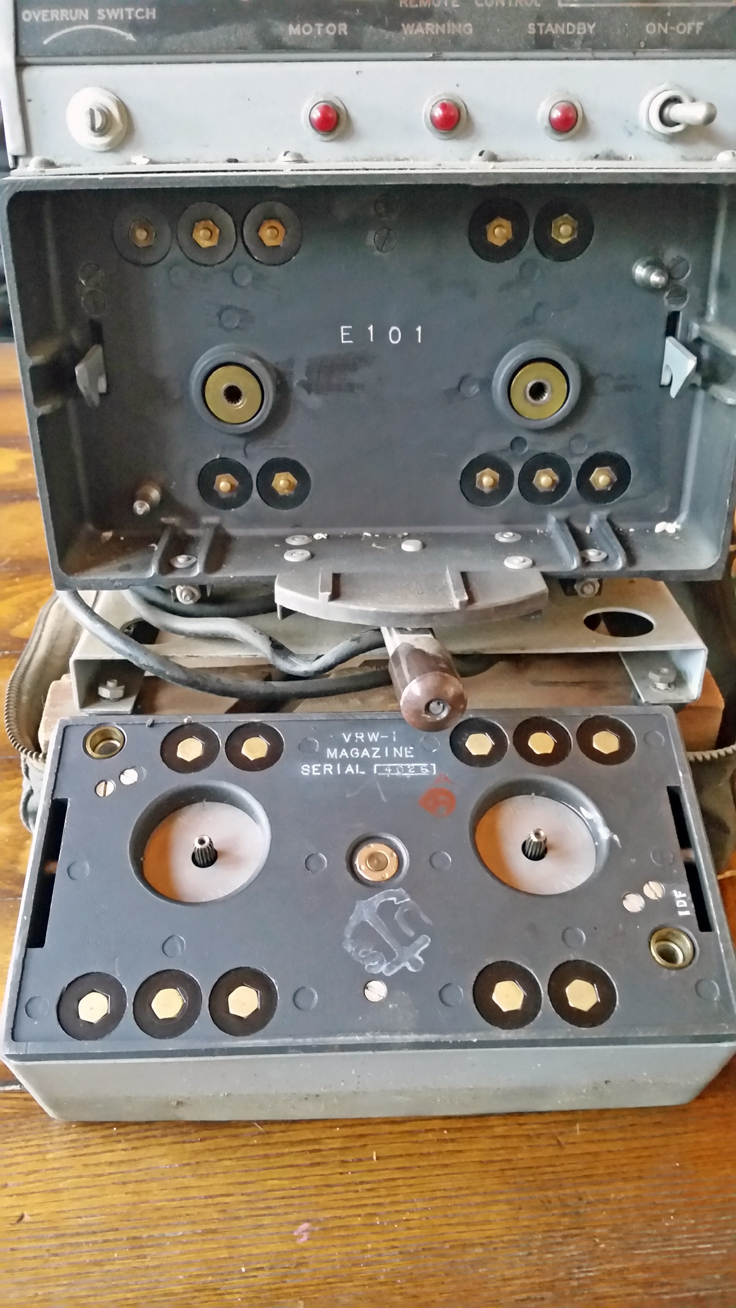
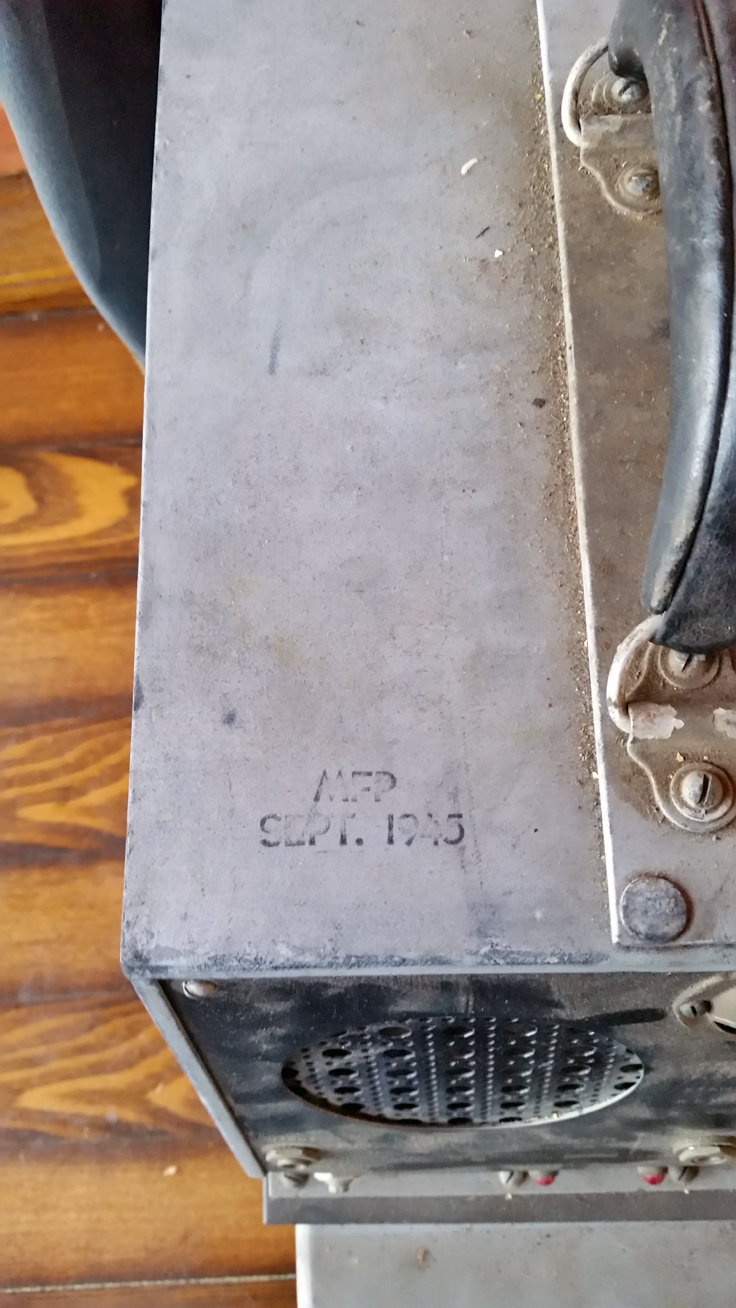
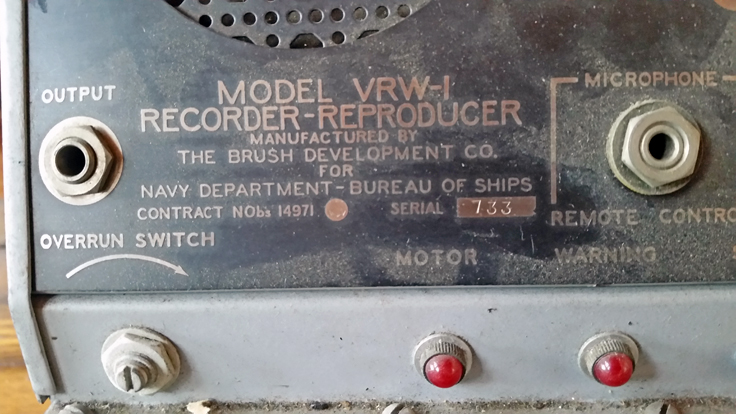
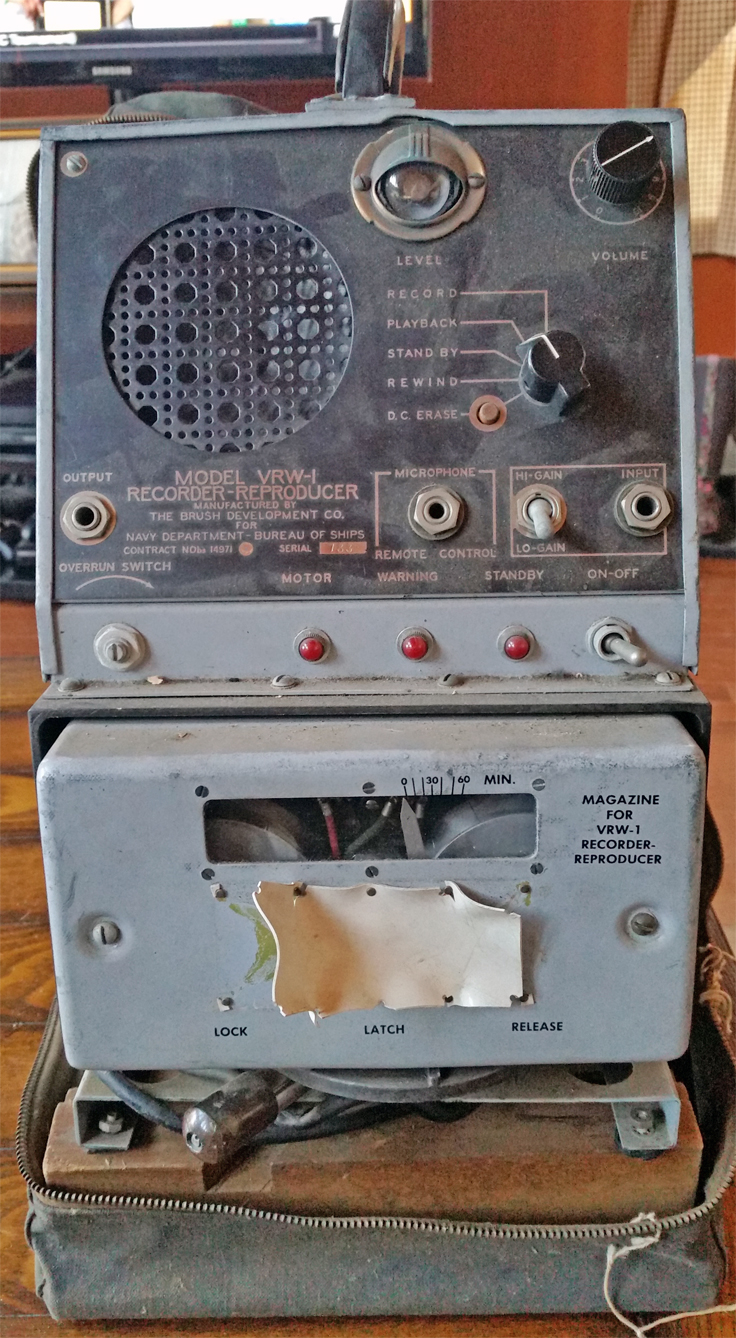
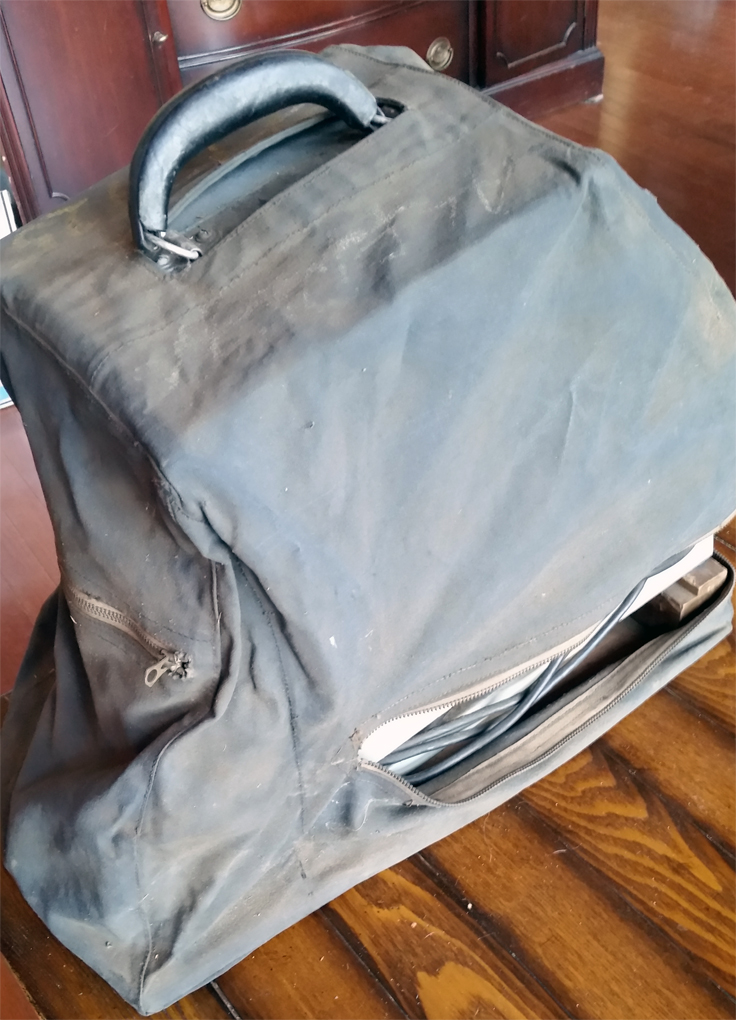
Brush BK 313 VRW-1 wire reel to reel recorder - U.S. Navy - photos above provided by Brett Goggin Minot, ME
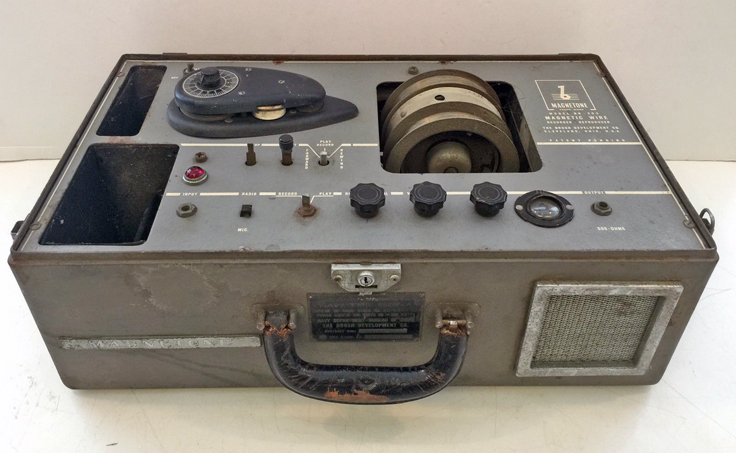
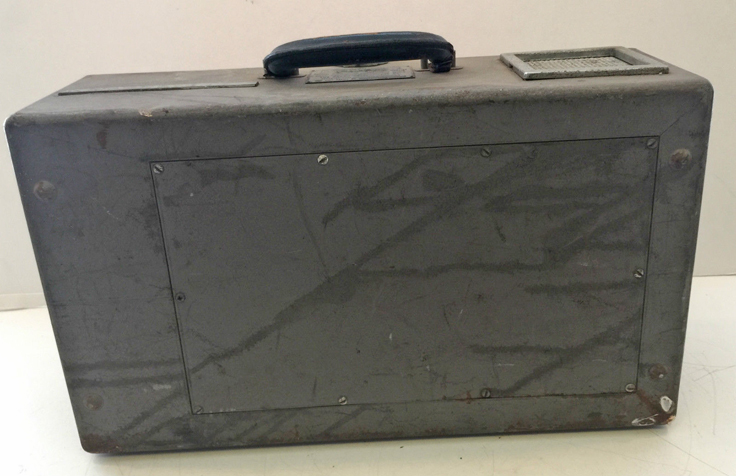
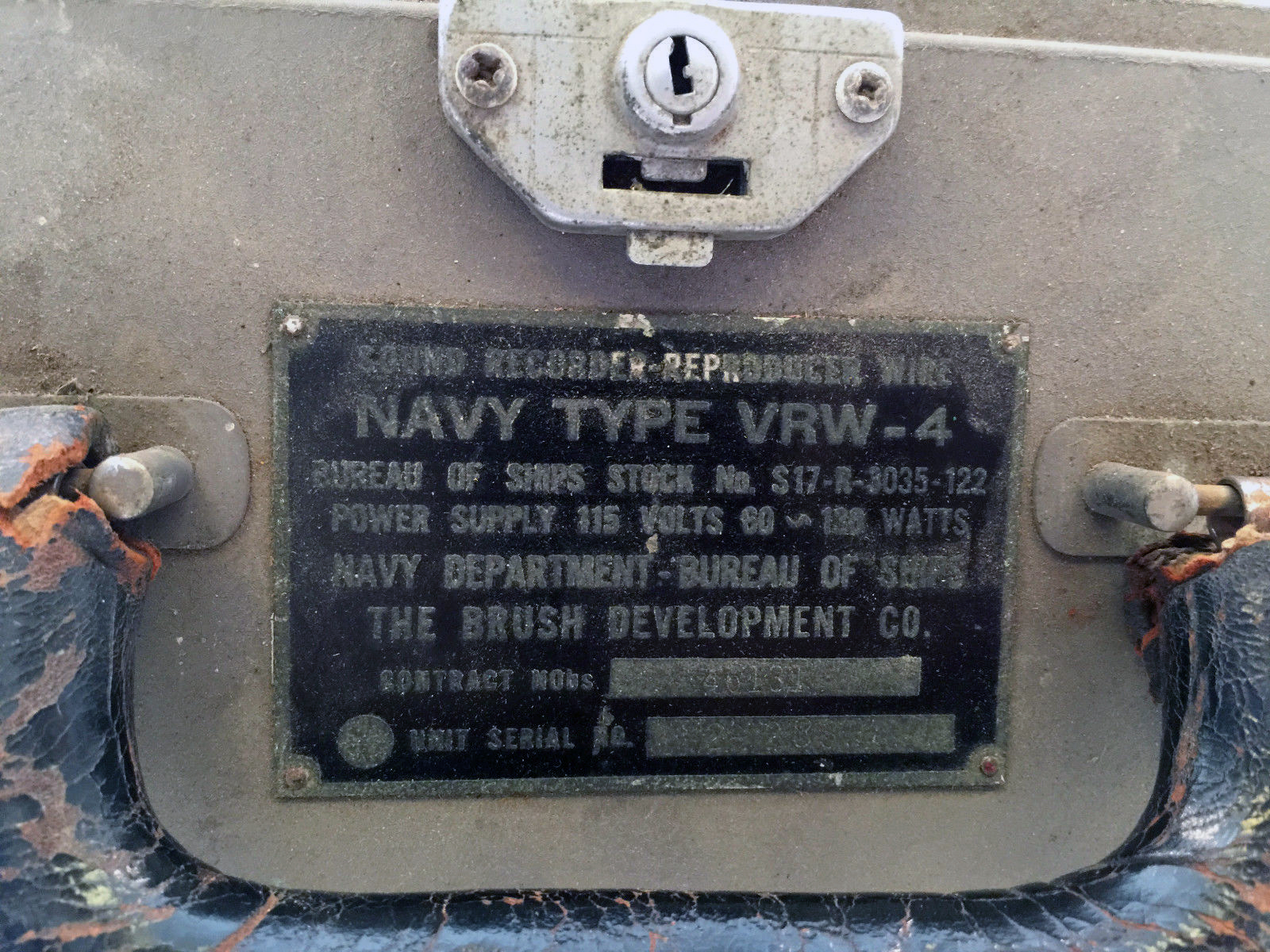
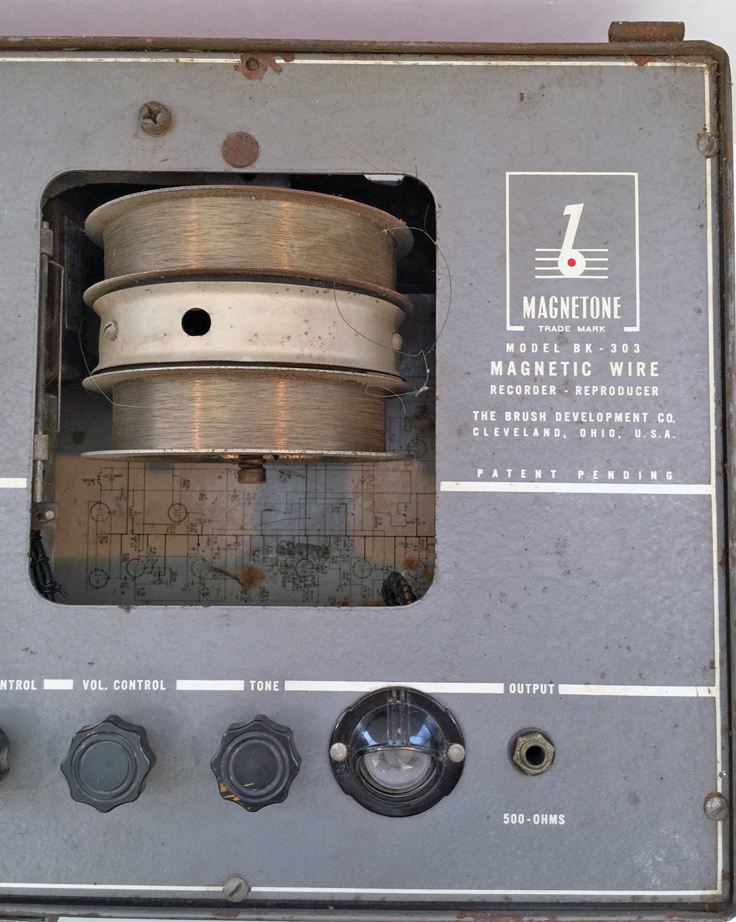
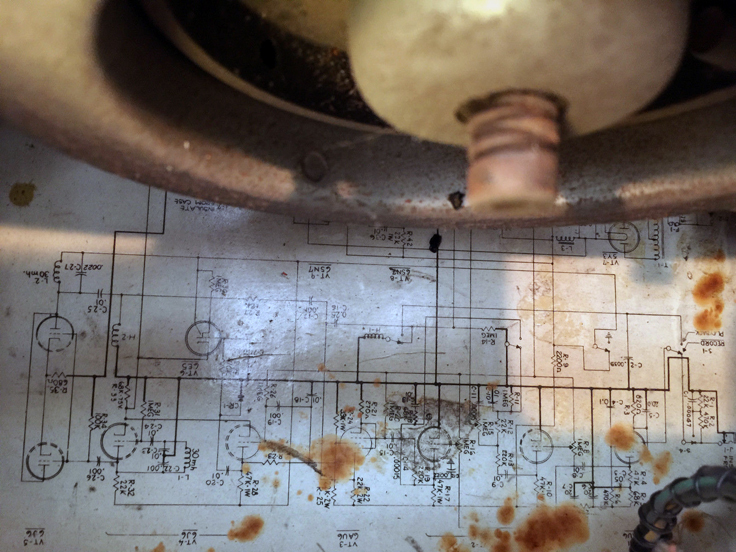
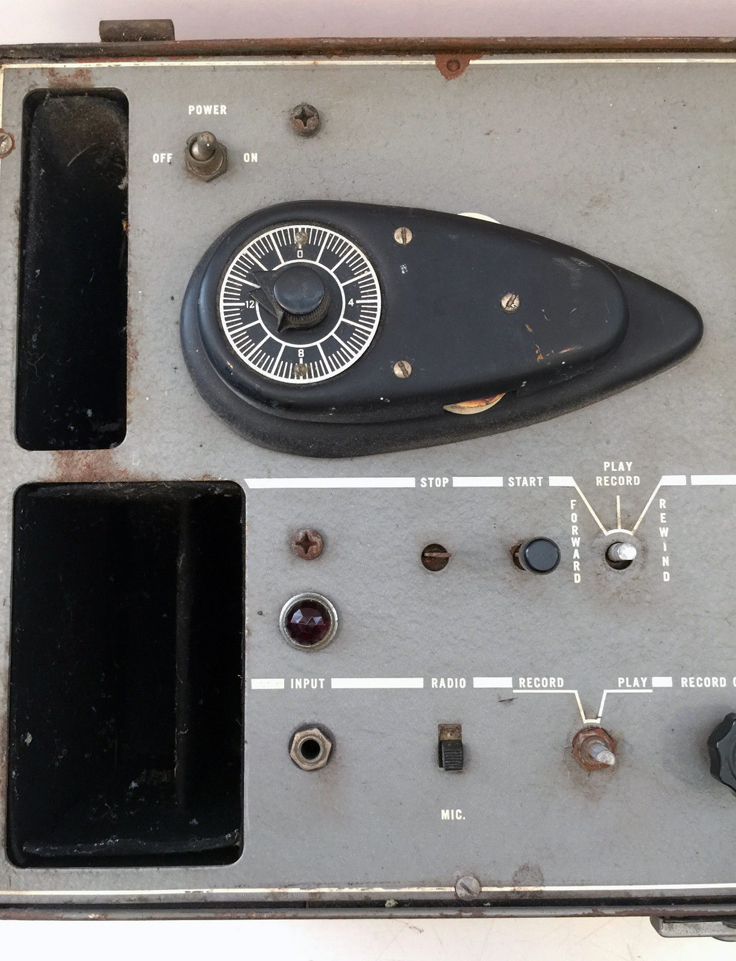
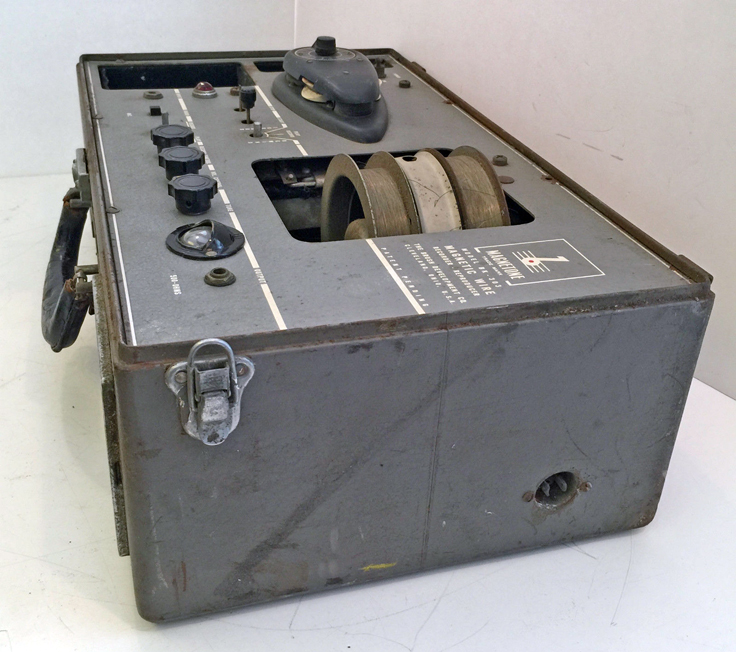

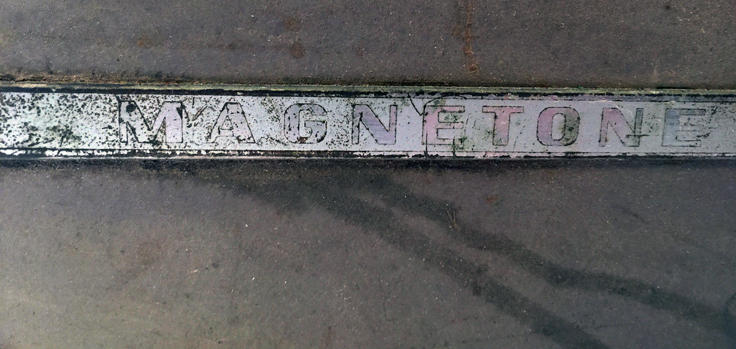
Brush BK 313 VRW-4wire reel to reel recorder - U.S Navy - photos above provided by Judy Dalton not2bright.com
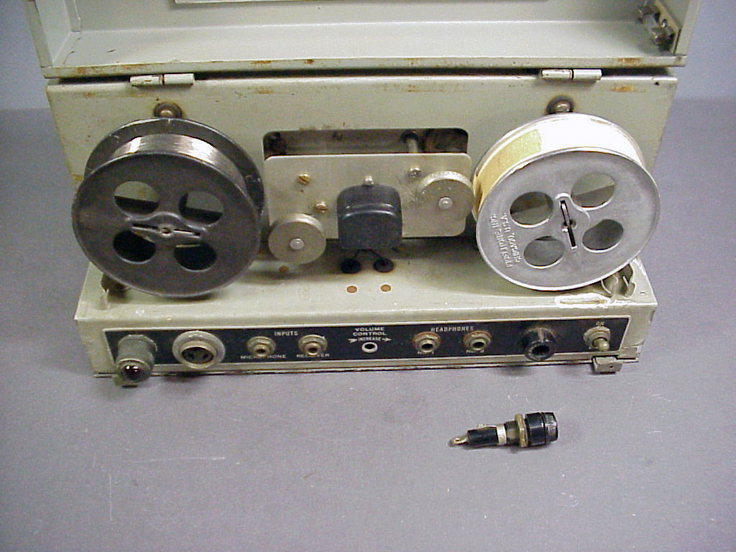
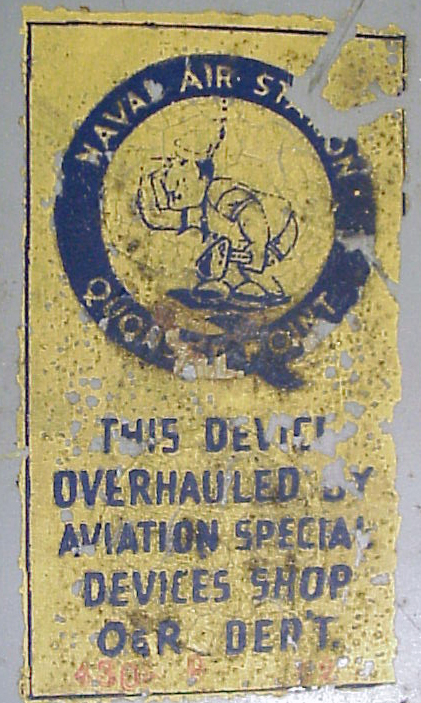
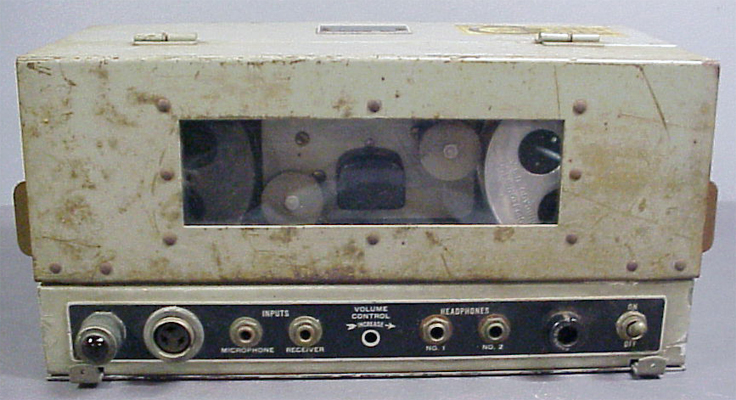
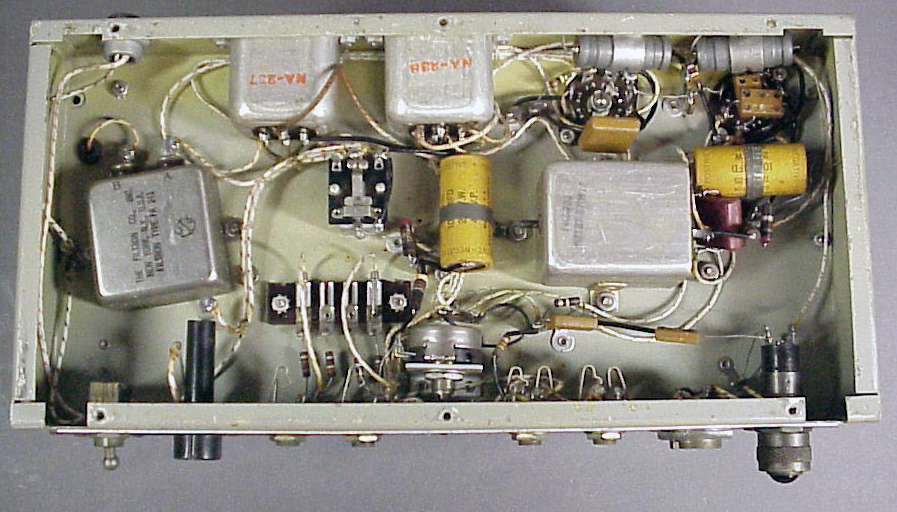
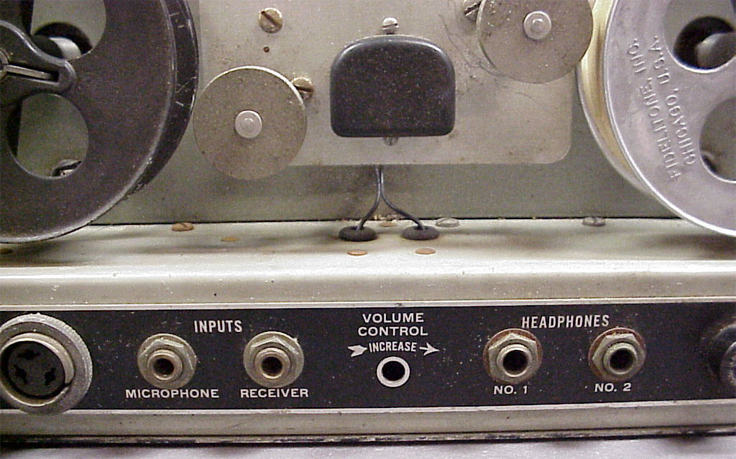
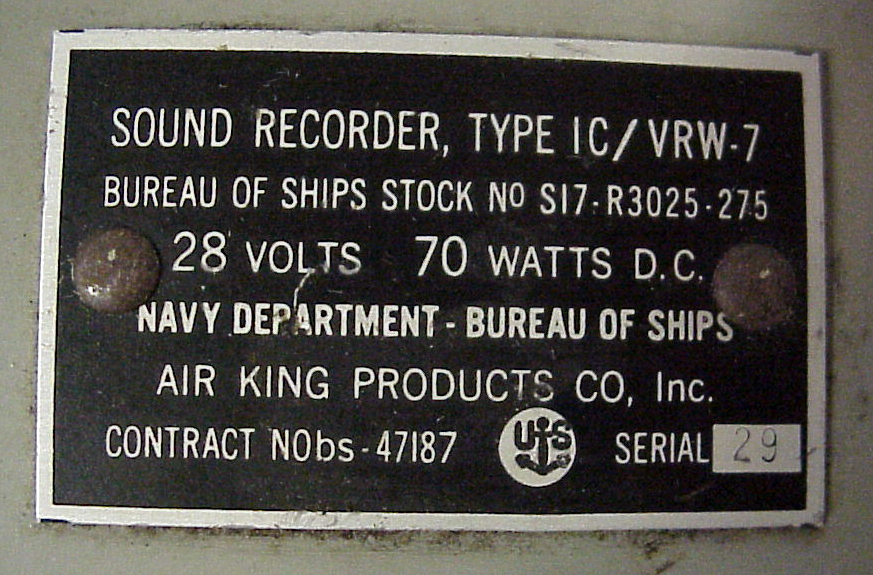
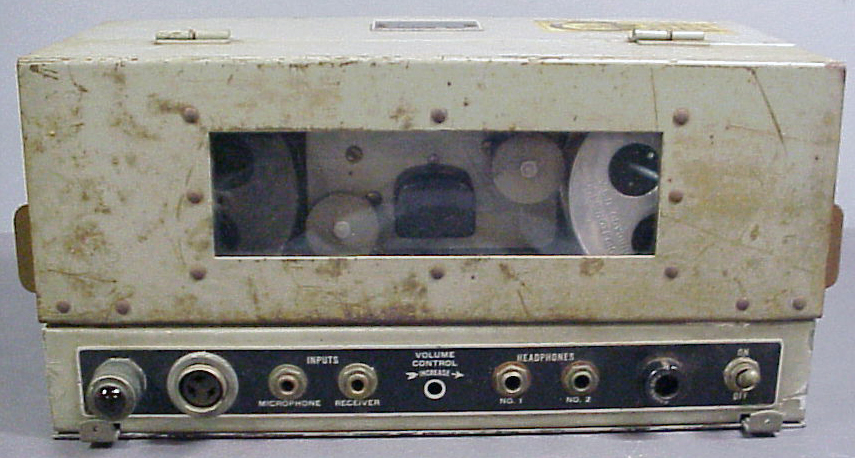
We appreciate all photos sent to our museum. We hope to successfully preserve the sound recording history. If we have not credited a photo, we do not know its origin if it was not taken by the contributor. Please let us know if a photo on our site belongs to you and is not credited. We will be happy to give you credit, or remove it if you so choose.
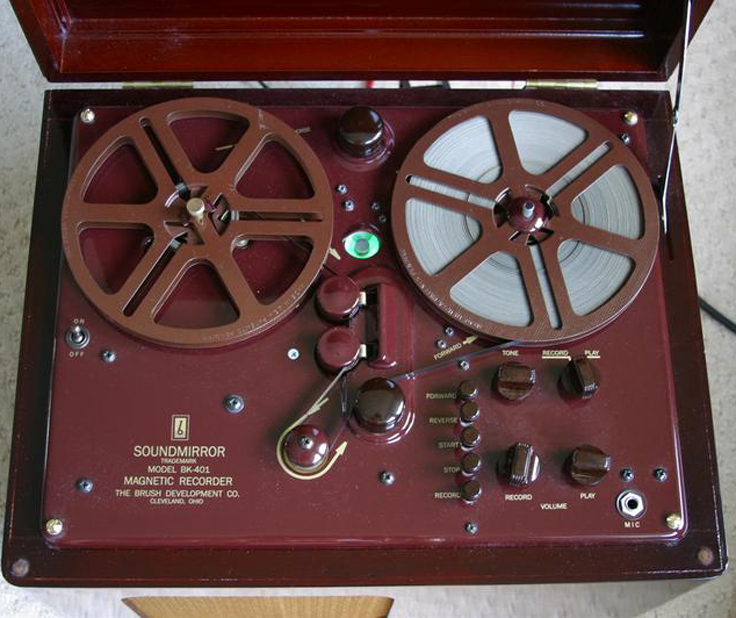
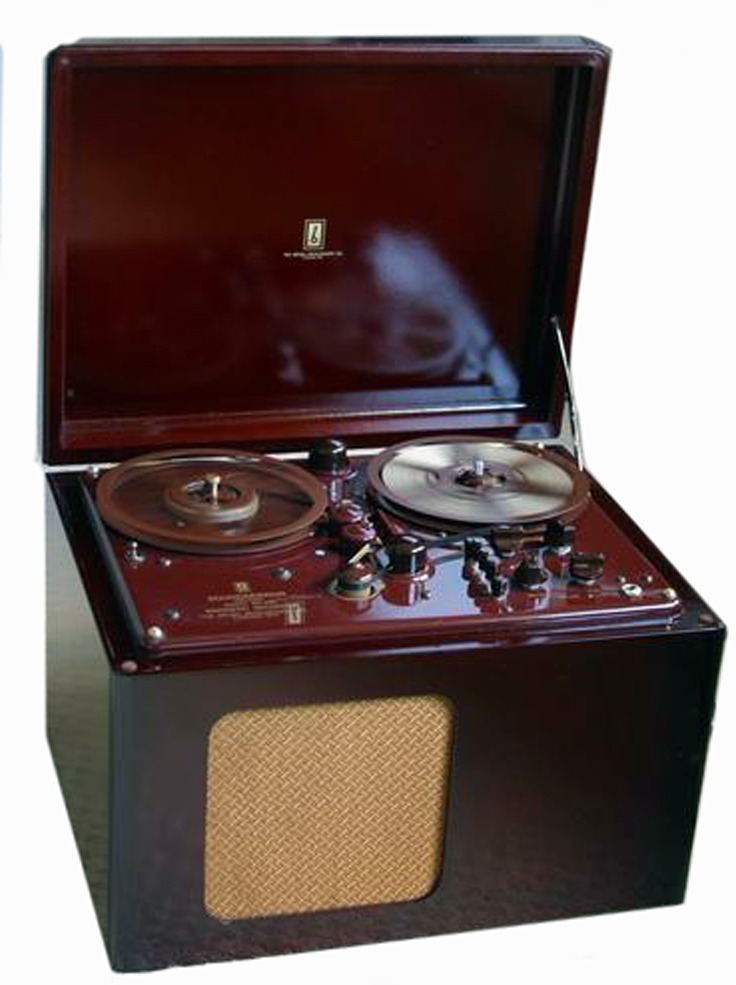
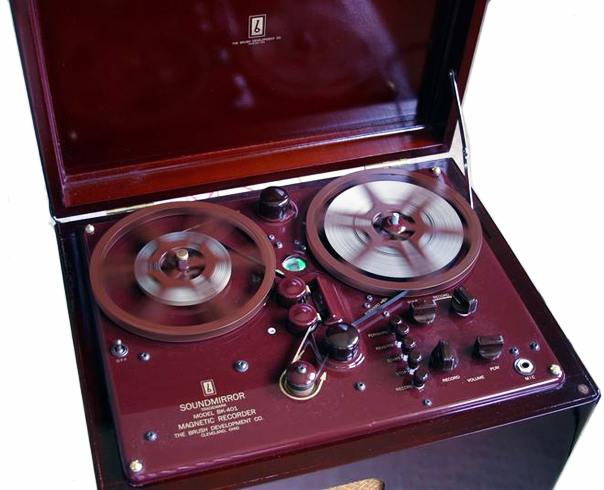
Brush Development Soundmirror BK-401
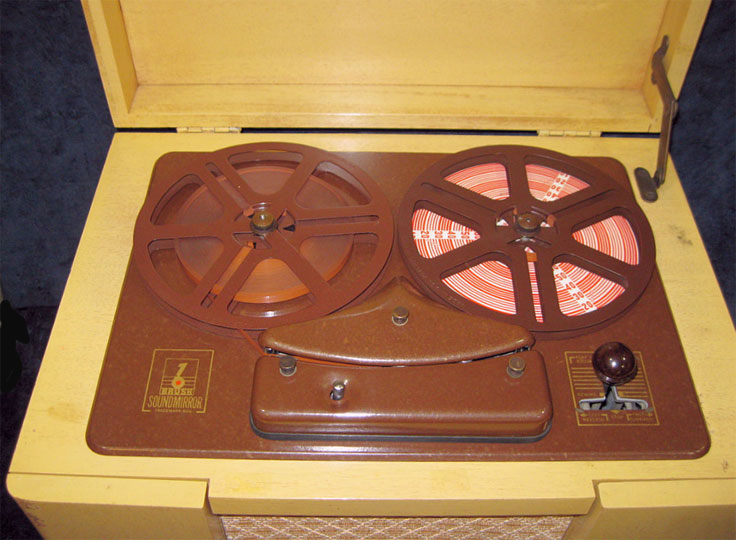
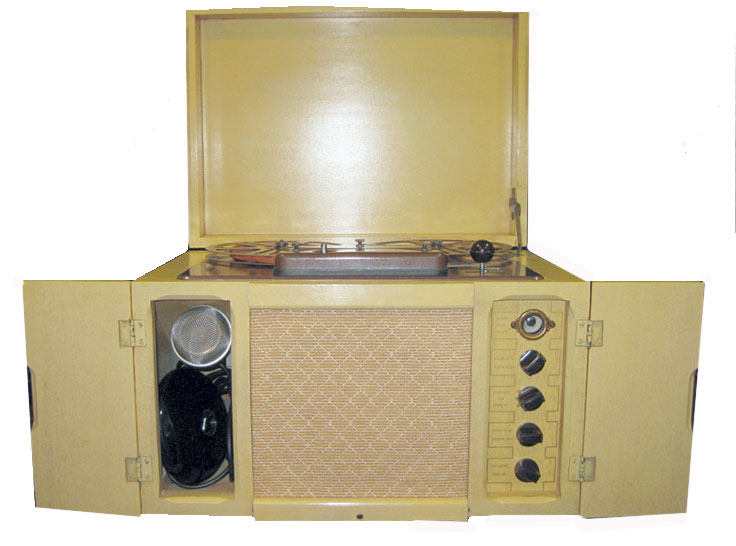
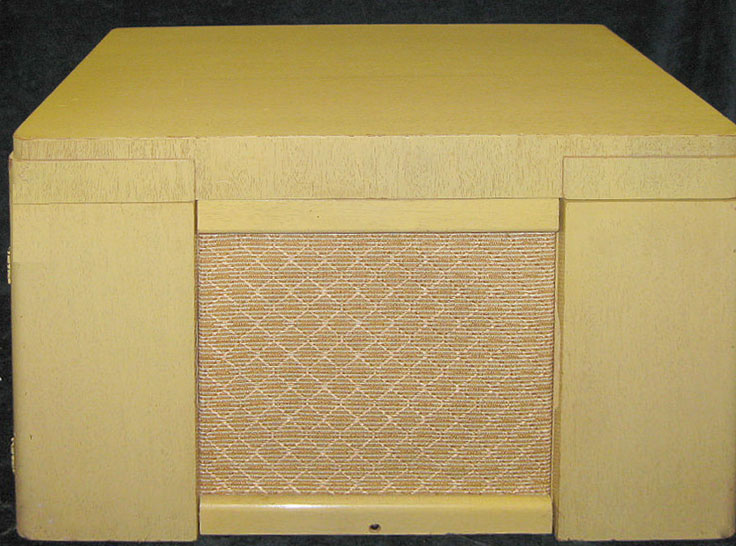
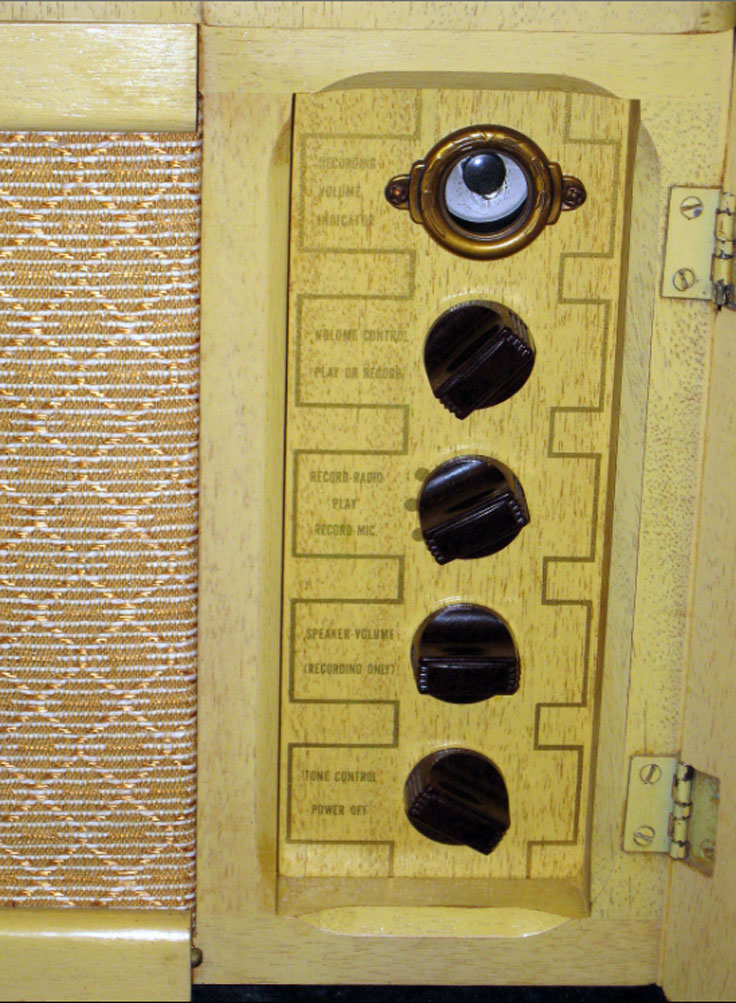
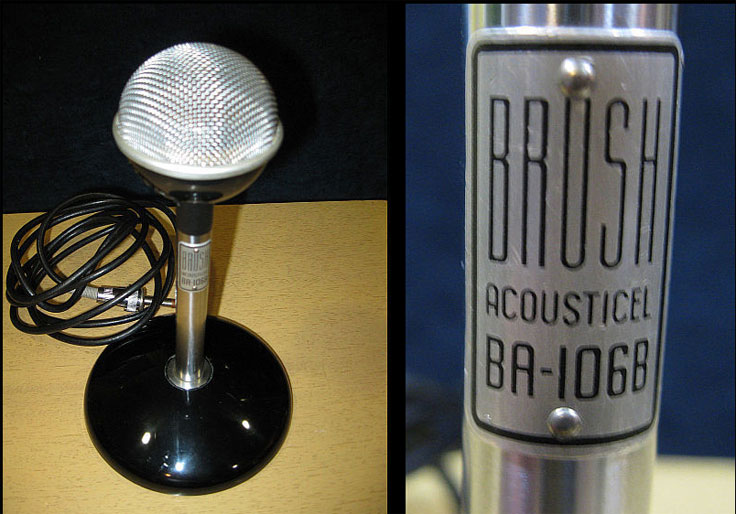

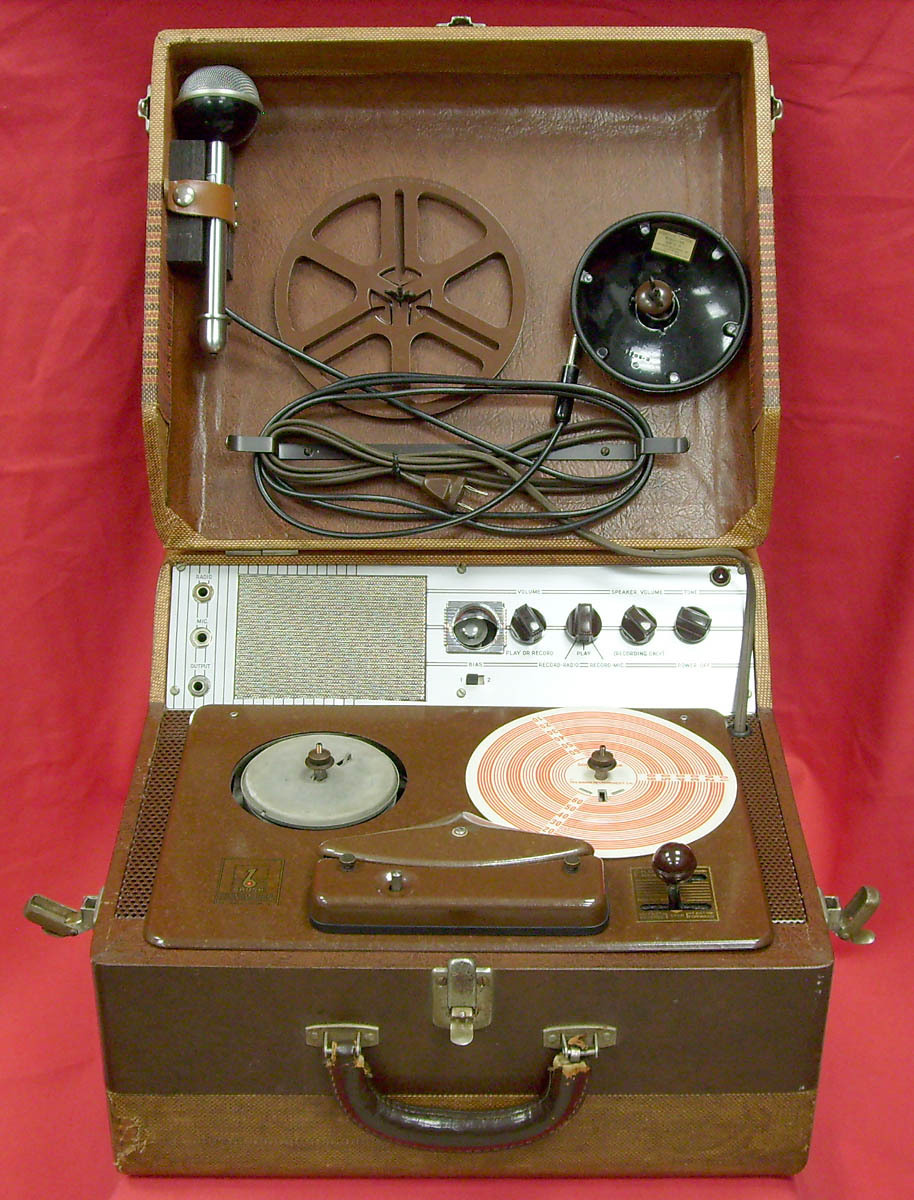
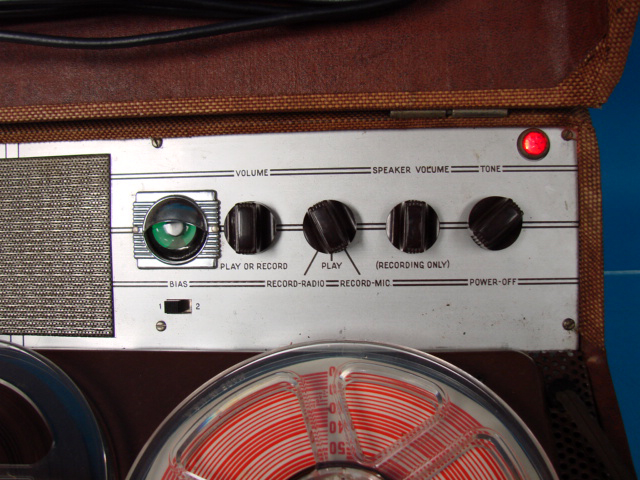
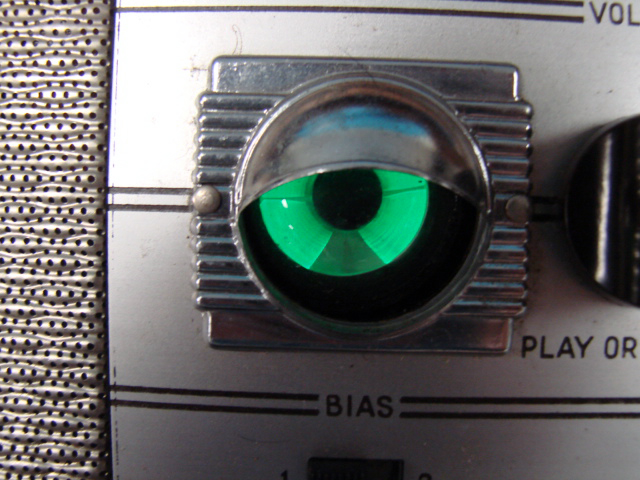
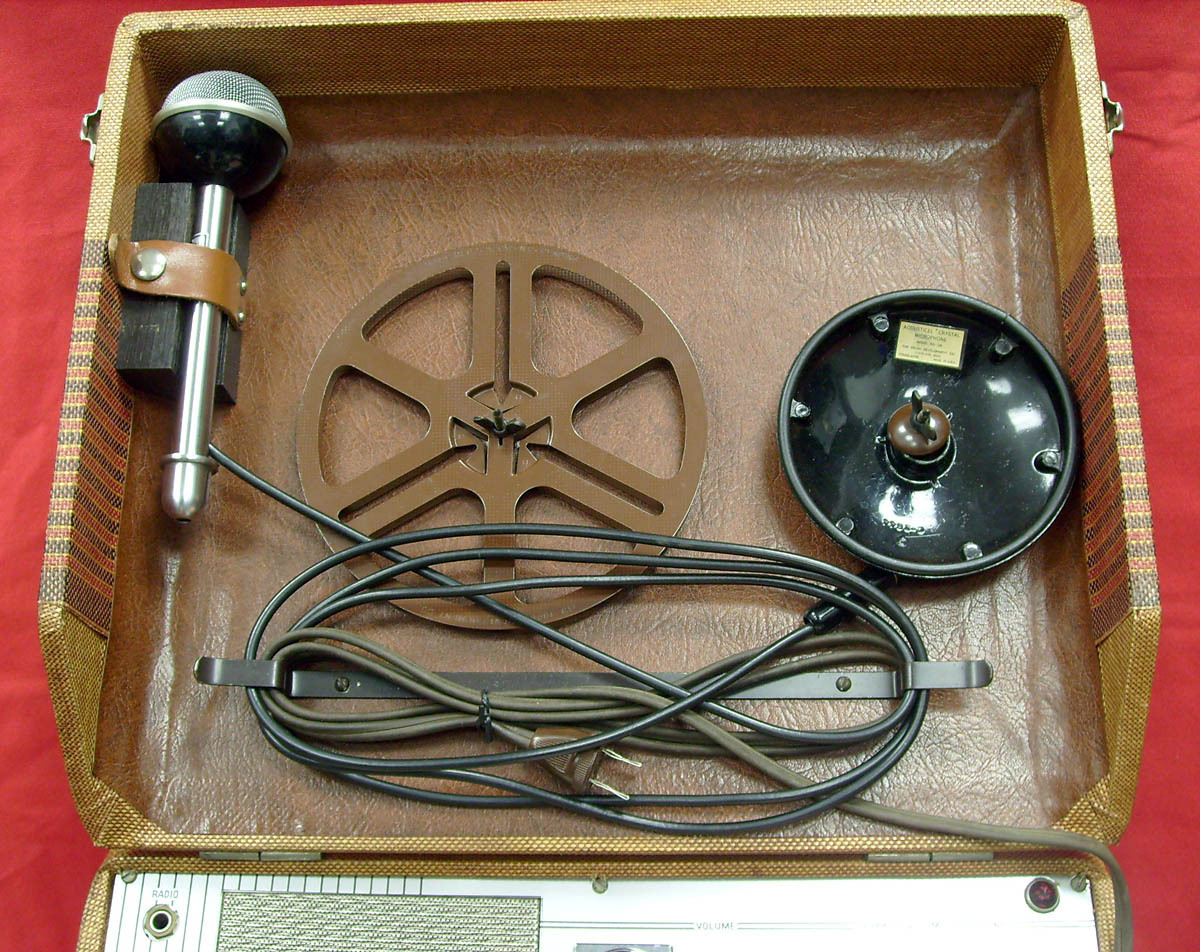

Brush Development Soundmirror BK-414

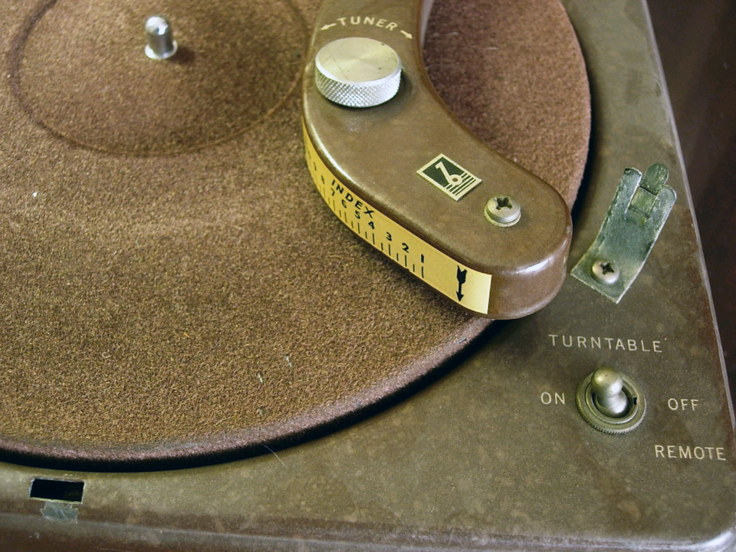

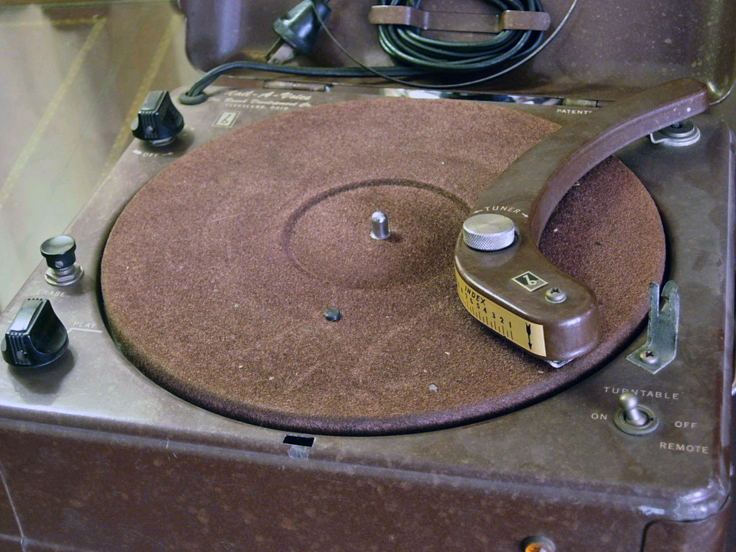
Brush Development Company Mail-A-Voice
Summary from eBay ad for old reel tape.
HISTORICALLY IMPORTANT CIRCA 1939-1945
THE BRUSH DEVELOPMENT CO. PAPER BACKED
MAGNETIC AUDIO-SOUND RECORDING
TAPE ON REEL MARKED "PATENTS
PENDING" IN 1931 PATENTED VENTILATED
CANISTER OF ALUMINUM MADE BY BELL &
HOWELL
THE BRUSH DEVELOPMENT CO - CLEVELAND, OHIO (USA) - MAGNETIC AUDIO RECORDING TAPE FROM
THE DAWN OF MODERN AUDIO RECORDING
In 1926 Charles Brush of Cleveland, Ohio sold the first piezo-electric featherweight stylus. Under the name "The Brush Development Company" piezo electric phonograph pickups and other things were manufactured nu the Brush company.
Soon the innovative company shifted to different types of recorders and later in the 1930's Brush began to experiment with developing magnetic tape recorders, called "Soundmirror" and by WW 2, had developed sufficiently
to sell paper tape sound recording equipment and technology to the US Military.
In the early 1950's the name "The Brush Development Company" had been changed to "Brush Electronics Company." The company stayed at the same address: 3405 Perkins Avenue, Cleveland 14, Ohio during this period in the 1950's.
A MORE CONCISE HISTORY TIMELINE:
1926 - Charles Brush sold the first piezo-electric featherweight stylus.
1938 Semi J. Begun (born in Hungary) of the C. Lorenz Company leaves Germany to start a new career in the United States. Lorenz then becomes owned by US Capital. In 1939 Begun takes a job at the Brush Development Company of Cleveland, Ohio. There Semi Begun began to develop the "Soundmirror" steel tape or wire recorder in early 1939 that would be used by the military.
But in Germany modern red oxide tape has been used by 1939. Bell / Western Electric stereo recordings LEF Independently, engineers in Germany, Japan and the U.S. discovered and develop AC biasing for magnetic recording as well. This work
followed through much of the 1930's and perfected by 1939.
Brush Development Company's main business in 1943 was the production of piezo electric phonograph pickups, the least expensive and most widely used pickup of the late 1930's - besides other activity.
During the World War 2 - Brush worked on a substitute for the stainless steel wire recorders. Then Brush with Ampex who made the 3M tape material and others worked on developing paper tape recorders. The singer Bing Crosby and Mullin (Ampex) became the catalyst innovators for tape recording in the USA.
It was this work that was ushered in with WW 2 that S. J. Begun began to develop the steel tape and coated-paper tape recorders for the US Military. Between 1942 and 1945 the company designed and successfully sold to the military various types of recorders utilizing plated media in the form of tapes, disks, and wire. At the end of war many "Magnetophons" of the German are taken to USA - commandeered by the invading US forces. German patent rights on the technology were seized by the U.S. Alien Property Custodian.
In 1946: The Brush Development Corp. built a semi-professional tape recorder known as the Model BK-401 (BK401) Soundmirror. The Brush Development company commercially introduced its Soundmirror paper tape recorder first developed in 1939-40. The Shellmar company manufactured the paper magnetite tape in 1946 for the Brush Soundmirror tape recorder and also a 5-inch magnetic disk for the Brush Mail-A-Voice disk recorder that sold for only $40.
A Brush licensee; Amplifier Corporation of America, introduced the Magnephone tape recorder based on
German technology.
Between 1952 and 1954 according to SAMS Photofacts the company name "The Brush Development Company" had been changed to "Brush Electronics Company". The company stayed at the same address: 3405 Perkins Avenue, Cleveland 14, Ohio.
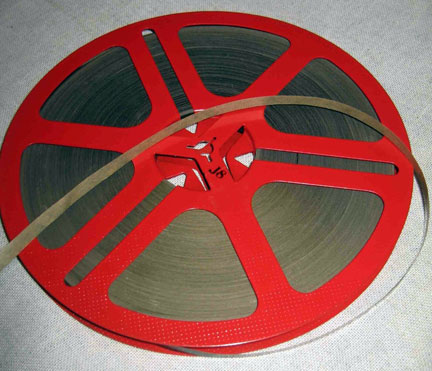 The tape we show here, because the reel is stamped "MADE IN USA - PATENTS PENDING" - could date this tape to the 1930-1940 period. The unique Bell and Howell canister of aluminum - with the unusual 'air filter screen' Ventilation system carries a patent number of "1826115" - which dates to October 6, 1931: THUS THE BRUSH TAPE with PATENTS
The tape we show here, because the reel is stamped "MADE IN USA - PATENTS PENDING" - could date this tape to the 1930-1940 period. The unique Bell and Howell canister of aluminum - with the unusual 'air filter screen' Ventilation system carries a patent number of "1826115" - which dates to October 6, 1931: THUS THE BRUSH TAPE with PATENTS
PENDING could very make this of the first production run
of tape made for the US Military after beginning development in 1939 - which went on to be sold to the US Military beginning in 1942 when the US entered World War 2, just after the bombing of Pearl Harbor in December of 1941.
Tape and reel is in new condition and Bell & Howell patented VENTILATED CANISTER, has minor scuffs on the outer surface.
As the canister has a Patent No. 1826115, which is for "Closures for Containers" and the patent number is from OCTOBER 6, 1931 - all of this thus appears to support that this recording tape with "MADE IN USA - PATENTS PENDING" impressed onto the RED metal reel along with "THE BRUSH DEVELOPMENT CO." name supports that this tape is likely from the era of 1939-1940 or possibly earlier. The tape is clearly not marked with the later 1950's name "THE BRUSH ELECTRIC CO." The canister is marked
in period pencil "DINNER MUSIC CLASSICAL" on
its lid.
A VERY RARE ARTIFACT FROM THE BIRTH OF MODERN MAGNETIC AUDIO SOUND RECORDING. arts and sciences

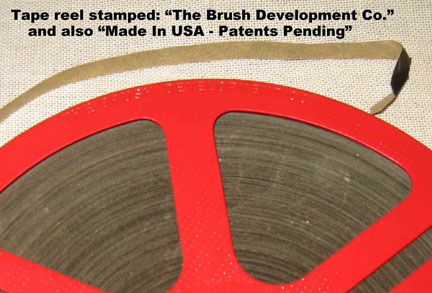
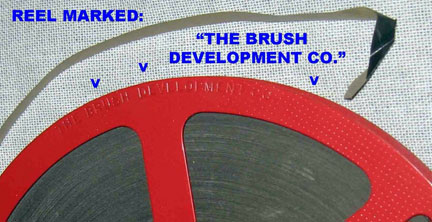
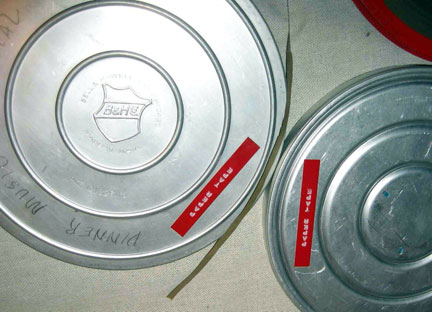
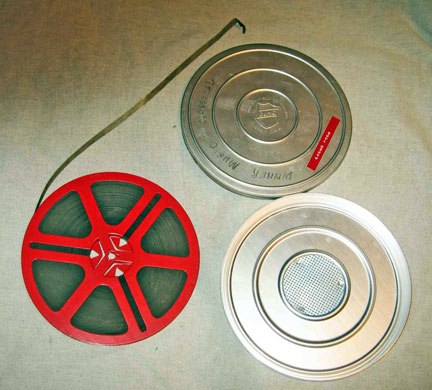
The non-profit Museum was dissolved on December 31, 2017. Donations are NOT tax deductible and are now processed by Phantom Productions.
All donations to MOMSR go 100% to support restoration of vintage magnetic recording devices in the private collection and help fund the web site development and hosting.



